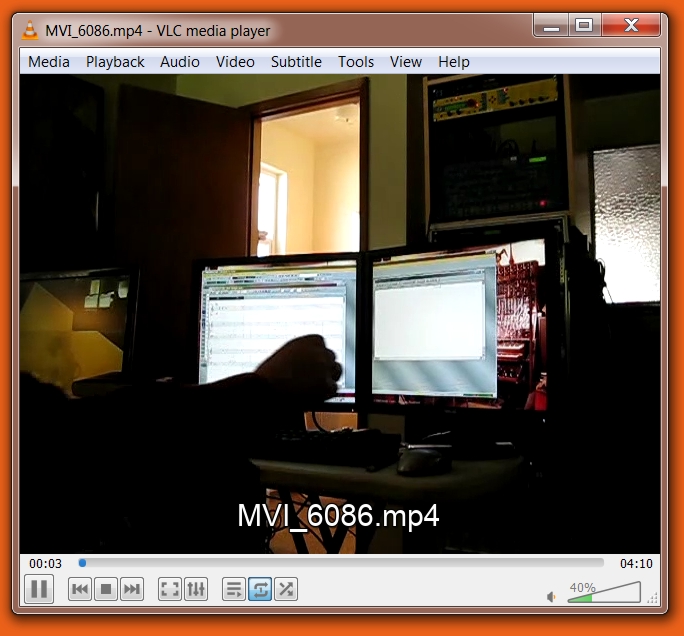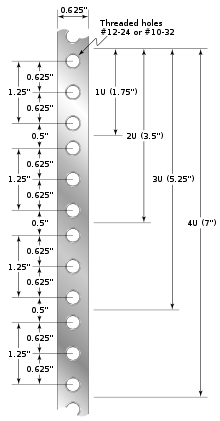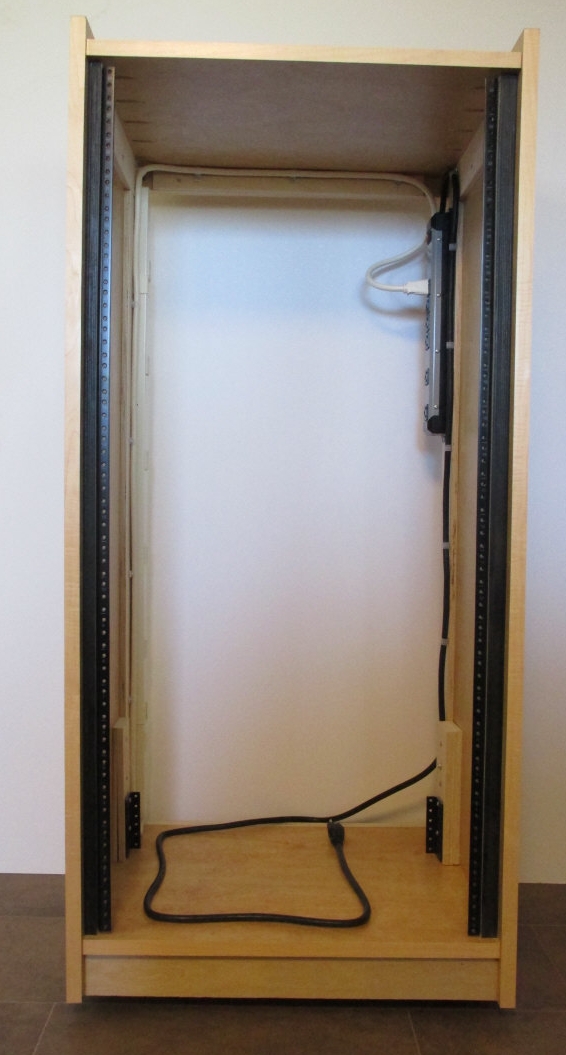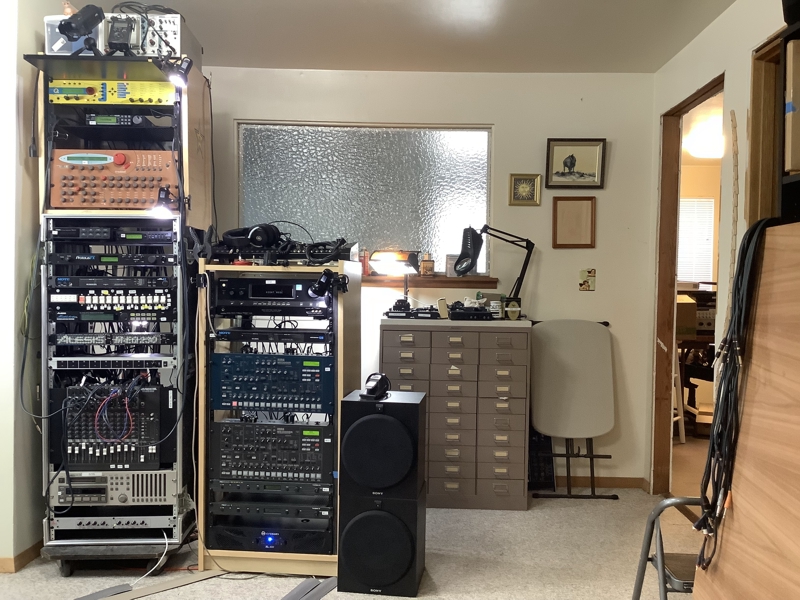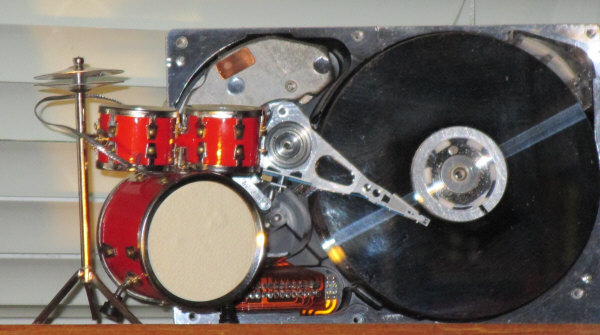Operating Guides and User Manuals at bottom of page.
This is where I live.
I needed a more accurate Fender Rhodes 73. So I got the Korg
Collection 5. It includes these 16 synth VSTs and a FX module
I originally bought one of these in 1973.
Very accurate Fender Rhodes. Sounds like my first 73 I bought
in 1972.
I'm looking forward to comparing the outputs of this VST and
the hardware MS-20M.
Project creep. Checking out the rack I found the Korg
NS5Rís two rear rubber feet turned to fluid. Even Goo-be-Gone had trouble
cleaning this up. Did the feet melt, were they of poor manufacture, or were they
broken down by a poor choice of cleaner?
These or some combination of them are the most likely causes.
Given this and other tell tail signs I have decided to make air flow the
King objective for the racks. To do this I now require a 1U space above and below any component that has
any exothermic properties like an amplifier or processor. Judgment by analysis
of the thermal impact is also used to maximize space usage. The only
non-exothermic component is the switcher. It has a front and back panel, is held
together with four bolts with tube spacers, and allows air to pass. I sandwiched
it between the MV4 and the MOTU XT. The bottom of
the Mackies is a label rail so no lower isolation space is required and better
yet if direct contact can be avoided. The typical rack unit illustration on this
page shows
the ĹĒ meet-me space. Some poor manufacturers encroach other good
manufacturers provide a slight gap. Mackie provides a slight gap. The Korg
MS2000s are narrow at the bottom and are designed to be shy of the rack space
meet line so I am allowing no lower isolation space. I didnít need to apply
this now and ended up using 1U with 90į audio and MIDI connectors so I can make
and change connection from the front of the rack. The Crown XLi
800 power amp has good interior thermal design so I allow it to be on the rack
floor but it still requires 1U isolation at the top.
The rack rails do not rest on the floor of the cabinet so there is a
slight gap providing no surface-to-surface thermal contact. FYI. in a traveling
rack always use a rear rail support for heavy components like power amps. To
continue with air flow only perforated rack shelves are used with components.
Also, for the components on the shelves, I installed tall feet to provide more
thermal isolation. The short cabinet has rack rails on both the front and rear.
Equipment was mostly interleaved providing air gapping front to rear. Some
components require other components to be floated temporally when making
connections. Not a show stopper.
More project creep. The Korg NS5R and X5DR both fried and
died. I'll send them with a Korg MS2000R into the repair shop. Maybe its just a
capacitor or other replaceable component that need fixing. I had already replaced the
MS2000R for recording Up to No Good with like, and now the X5DR with like, and the NS5R with a NX5R.
More project creep again. Get audio from computer synths
into mixer for composition setup. Configure to allow the computer audio to be
routed to stereo and 5.1 surround for mastering bypassing mixer.
For the Mackies, 90į IEC C14
to C13 AC plugs are added to reduce the minimum clearance. There are two kinds,
those that turn down at the female ground and those that turn up at the female
ground. Do these create AC noise? This always needs to be evaluated after
installation. I found none initially but later found one of them to be a loose
connection. Will purchase replacement..
I cleaned all the synths with Endust
for electronics, Safe even for plastic and monitor screens. Donít use on
electrical contacts and it may act as an insulator.
After all the components were arranged the powering was set
up. The wall warts and AC cables were connected. The two MOTUs have a USB type B
connector. This means they are USB type 2.0 compliant. Thatís a cable length
limit of 5 meters or about 16.5 feet. The MOTU 128 is only powered through the
USB so I decided to install a USB 2.0 powering hub in the cabinet. With a
combination of Type A to A, an extension cable and
two type A to B cables with the hub the components were powered and the data
link setup. This resulted in a 15 ft. run.
All the MIDI cabling was done keeping the cables as short
as possible. The location of the MOTU MIDI interfaces in the cabinets was chosen
with this in mind. All the synth fronts were labeled as to their MIDI port
assignments.
All the audio cables were routed to the Mackies
for the composition setup. The audio
contacts were cleaned with Deoxit D5. Cable lengths
were kept short. All the mixer
channels were labeled with the synth names.
These will change and the labels updated as necessary.
Cakewalk by Bandlab. This DAW
is free and as I have been using some version of Cakewalk since forever so Iím
starting with it in the Win 10 environment. One thing is for sure if you have
real synths donít lose your Instrument
Definition Files and maintain copies of these and your Master.ins
file. It is getting more and more difficult to find them on the net. Even Bandlab
has made it difficult and no longer maintains any access to them on their web
site. I performed a find operation for Master.ins
and found in in three locations.
C:\Users\HP\AppData\Roaming\Cakewalk\Cakewalk
Core
C:\Cakewalk
Content\Cakewalk Core\Instruments
C:\ProgramData\Cakewalk\Cakewalk
Core
Iím using general MIDI for the Yamahas and a Proteus/01 for the
Proteus/03. The Korg MS2000R and BR are using the
same R type instrument file. I have never found any instrument files for these.
In a perfect world I need to create instrument files for these. At a minimum the
voice names need to match. Thatís a lot of typing and transcribing. I
understand that a SysEx file can be downloaded from
each synth and it contains the names. Iíll be trying that first if i can't
fine a digital list as there a 1000 plus voice names involved.
The Clockworks app has to be setup. I visited the app and
didnít do much as Iím not setting up the clock and SMPTE/MMC yet as Iíll
do this when setting up and testing the recording process. The Presonus is on
backorder it won't arrive until early November,
I backed up the Win 10ís initial Master.ins
files and replaced the three of them with the Master.ins
file from the Win 98 environment.
Then in Cakewalk the MIDI output/input configuration needs
to be set up. To do this navigate to Edit/Preferences/instruments and work with
the right side of the menu. If you are not chaining your MIDI connections each
of the 16 MIDI channels for each port need to be connected through its
corresponding MIDI connection to the synth.
I then performed a synth-by-synth test of the system.
Everything worked fine except the two synths that did not have their In/Outs
transposed. At first blush the audio quality is very good and noise free. I did
not test each synth for its knee of the curve noise point.
All amplifiers at some point go into overdrive. I will be doing this when
I fine tune the system. And when I record. I donít want any amplifier
overdrive noise when composing or especially when recording. When I want noise
it will be part of the programmed wave inside the synth or inside the computer
with a VST FX app.
For the Tascam DA-38 I use a Behringer MDX-1800 Protector.
This component acts as a transient peak limiter before the audio goes through to
the DAC. This allows the average volume to be hotter while preventing the
transient peak amplitude from over saturating the digital converters and
creating the unpleasant noise. These
are no longer being made. The one I have is dedicated to the DA-38 and I now
need another for the eight Presonus channels.
I have decided on getting two of the Behringer
Multicom Pro-XL MDX4600 V2s. This will provide eight limiters in
front of the Presonus DACs. I am expecting
coloration differences. I will deal with that on the front plane and in the DAW
environment. There is not enough rack space for these with 1U spacing for all
hot components. More racking required.
Cakewalk by Bandlab
As Cakewalk is
free I thought, because it's my MIDI and music notation software of
choice, I would start here. I have been using 1998/99 Cakewalk from the
beginning and
did not upgrade through the iterations of Sonar. There are a couple of things
that were changed for the worse and the remaining is real fine, I would
pay for it. The one thing I hate is the big X that appears when using the
pointer to choose the location on the staff where the pearl is place. Right like
I w2ould want a big blackout that obscures the visibility of the point of pen.
How could I be the only one that thinks this big X is a good thing? Maybe no one
likes notation as a primary source of input any more? Maybe it can be turned off
somehow... on a search now!
Oh found another. When active in Staff, Console,
Event List or more quick saves using keypad not accessible.
:
This is a screen shot of my normal work
space. I'm using four LG 24UD58 B 4k monitors 2 by 2. So when you click on this
picture below you will see its a giant desktop. The right two screens can be toggled
from staff to, console to, event list...usually. This setup only shows the
external synths so far. For internal I'm looking for a real good grand piano, a
Wurlitzer and more strings, horns and synths. Plus lots of processors and
effects with low noise.
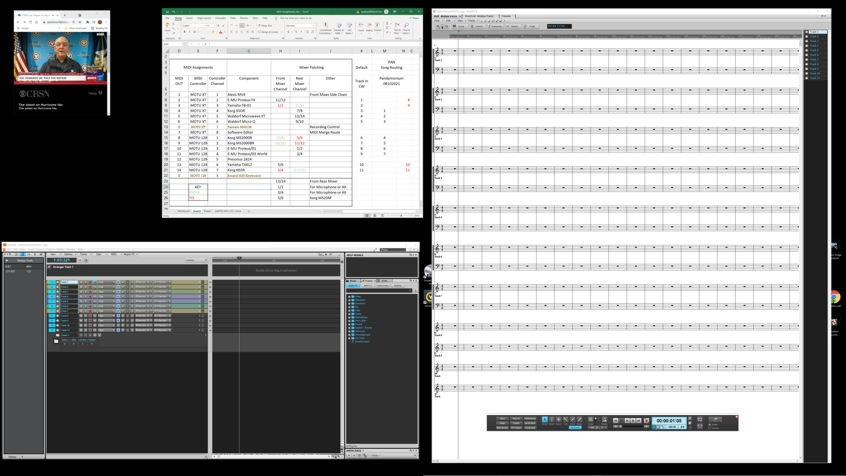
:
My
Computers
:
System Design and Testing
For the DAW voices I need to route them to the mixer
for composition. Testing all the options; the USB audio device, the digital audio band in the
video HDMI stream, and the optical audio output of the motherboard through the
SPDIF optical connection and two types of downstream DACs that turn the digital
sound to analog, to find the best sounding and lowest latency path.. There is also the ASIO (Audio Stream In/Out) for sound
cards. The Win 10 HP 871040si CTO has no video card and no PCIe slot for one so
its the USB, HDMI or SPDIF. Planning to achieve the minimum latency I narrowed
the choice set to the HDMI or the optical SPDIF. I also need full and balanced
sound frequency with low noise. I have a small HDMI break out box with headphone
and SPDIF, It works but the headphone is not designed for full balanced
frequency generation. Lack of low and mid range. Using the SPDIF requires
another component that has a DAC because the optical is still digital. The Nvida
GeForce RTX 2080 video card is great for video and the HDMI audio should be very
good and do 5.1 surround sound but it isn't ASIO compliant. The SPDIF
should have all the information the HDMI has except the LFE channel. That's the
low frequency effect channel Sony standard for movies. I also have a Sony Multi
Channel Receiver STR-DH800. It can do everything including Video, 5.1, stereo
plus everything in between, using HDMI and SPDIF. The question is which
component the video card or on board audio have the lowest latency. I'm
betting the i9-9900K processor will be more than enough for audio. I like this
better than the video as I would have to route a long HDMI video cable to the
rack and back again to a monitor. I prefer to route a Toslink fiber cable from
the computers to the STR- DH800 getting the analog in the rack allowing me to do
stereo and 5.1 with some additional speaker setup. The optical routes in the
studio are up to 30 ft. With fiber optics this is not a lossy limitation. Those photons move a little
faster than electrons do with this type of fiber at these distances.
The Rocker Switch
Is Retired 07/2023. The last function was bridging the oscilloscope. Now
the scope is bridged via the headphone output of (the new, 3rd) Mackie 1402
summing mixer.
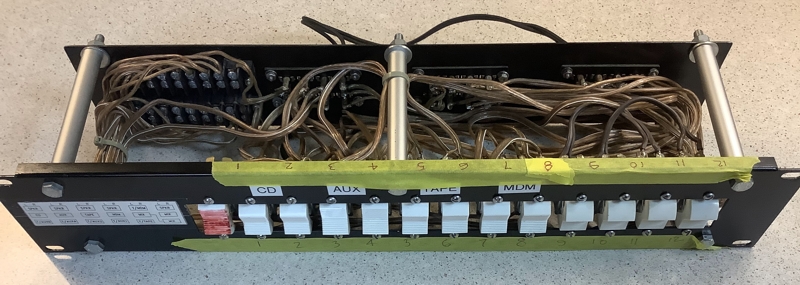
Optical
SPDIF or HDMI
Technically
optical sound should be better than USB or analogue out of the computer. The
following paths were tested; optical port from the i9 Win 10 board, HDMI
optical breakout box off the Win 10 computer through a Nvida GeForce RTX 2080 video
card, optical port from the i5 Win 7 system through a Creative Sound Blaster Z
card. Destinations of the optical SPDIF to convert the digital to analogue
stereo; a Sony STR-DH800 Multi Channel Receiver and a low cost optical
SPDIF to stereo DAC box. The post DAC to analog paths tested were through the
Mackie to the dbx crossover to the Crown power amp to the Yamaha NS6490
bookshelf speakers and the stereo Sony SA W2500 subwoofers and bypassing the
Mackie straight to the same analog chain.
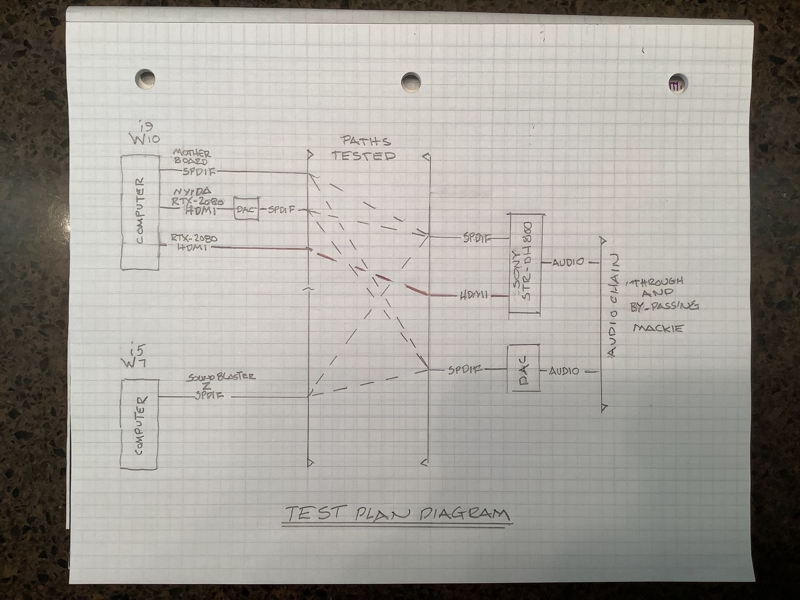
There
is practically no audible difference between all the SPDIF paths and DAC
components. None of the optical SPDIF alternatives tested as shown in
the above diagram provided acceptable audio quality for composition or for final mixing. There was no comparison
between the SPDIF and the
HDMI audio path. HDMI is the winner! I'm more than little disappointed. I'll never use optical
SPDIF. I'm disappointed because I use to record eight channels of uncompressed
audio into the Win 98 computer over a optical Toslink with ADAT specification
components. Conclusion- SPDIF is a wholly inadequate protocol... a real POS.
USB audio sounds better than optical SPDIF. If there is a good way to use the SPDIF I don't know about it I tested it as far as I could afford to. I was
going to test all for latency now I find that would be a waste of time. If I end
up with any latency issues I'll actually have to get another computer. Crap.
:
Audio
Plan
This provides versatility for stereo and 5.1 surround sound
mastering. Exactly on point for the Synthmind Studio requirements.
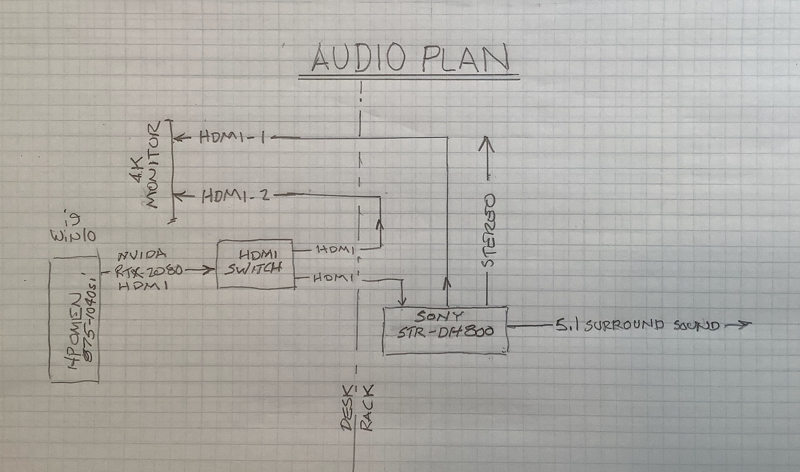
Video Test
Testing the video through the HDMI switch I find after its been on for a
while short blackouts and flashes occur. This is latency. Its caused by a
clocking discrepancy that creates rippling errors resulting in jitter and
blackouts. This switch is not bi-directional and works very well with two
in and one out. I'm getting another switch that says its bi-directional as the
network requires one in two out. So the next
computer has two must haves; a Video slot, a PCIe slot for a sound card, and
HDMI video off the motherboard. This will allow for four monitors plus the
ability to acquire audio from a ASIO compliant sound card and through the processor from the
HDMI off the motherboard. If the i9 Omen by HP had HDMI on the motherboard I
would not need a switch or the return path to a monitor. The audio plan commits
me to bring all the surround speakers into the studio from the TV room and
moving furniture. Putting Surround in the studio is going to be fun, Not. I may need
to hire help to move the micro mount mineral collection cabinets. The room has a
half bath in one corner, Its the best bass trap. I actually sit in there when
auditioning a mix to evaluate the bass and sub-bass registers. Switch found
to be buggy. Replacing to see if it can be bettered.
Studio
Wisdom... For every device that's added a half dozen or more cords are required.
Line Balancing
Establishing volume balancing default setting includes the
following correction points, The MIDI Note Value, The synth's Volume Control
Setting, the synth's Internal MIDI Volume Setting, ton the mixer he Gain Control
setting the Three Frequency Band Pots, the channel's Volume Slider, and the
Mains Out volume setting. When keeping all the components unchanged down the
chain to the speakers, I'm looking to even out the shy and the monsters. I can
always make a voice a monster say like the bass force of a rap song or make shy
the hairpinning of a sound the studio needs to start at a even baseline. Some
synths are hot like the Waldorfs some are shy like the FX and some gain noise at
louder volume.
Phase Error Correction
I use an external and an
internal oscilloscopes to test for wave cancellation due to out of phase waves
colliding. For my external scope I bridge it to the final audio path to the
preamp. I loose a decibel just enough to be perceptible. I set the scope
to a ring rather than the sinusoidal form and set it centroidal to the center of
the quadratic grid. if the ellipse is in the lower left and upper right quad the
sum is in phase and if the ellipse is in the upper left and lower right quad the
sound sum is out of phase.
Roland A-30 76 Key
Controller Keyboard
During the rebuilding of the studio the keyboard
went wonky. A few keys would only play fortissimo. I disassembled the keyboard.
Lots and lots of #2 phillips. First place the keyboard keys down on a padded
table so the controllers are just beyond the edge of the table to insure no
resting weight is exerted on them. Remove all bottom screws first. Holding the
top and bottom halves together flip the keyboard 180į so the keys are up. Pull
the stretched "U" shaped parameter piece that includes the two
controllers off and disconnect the two flat cable connections then set carefully
aside, Flip the keyboard again with the same care so the keys are down. Remove
the two sets of two screws holding the key assembly to the bottom shell lifting
it up while tilting 90į and disconnect the two flat cable connections and
remove. Flip the key assembly. Inspecting this I saw white precipitate in the
same area as the bad keys. To clean away any foreign contamination the specific
contact strip had to be partially lifted. First I removed the whole contact
board. Inspecting the underside of the board there are tiny rubber cylinders
penetrating the board. Some, the smaller size, are flush and the bigger (still
tiny) cylinders are proud. After flipping the board over evaluated which contact
membrane needs lifting gently lifted it up at a corner by picking at it
with a fingernail then did the same to the adjacent corner so as to not put any
undo stretching force on it. Continue to lift up the membrane as needed to
reveal the contaminated area. Using Deoxit F5 and Q tips cleaned the board and
membrane contacts, twice. Let dry and repeat. To reassemble the membrane first align
a set of the smaller nibs with their corresponding holes align and press
together. After aligning and penetrating some smaller sets using the eraser end
of a pencil insert the larger nubs, After all the nubs are inserted flip the
board over and using fingernails like tweezers gently pull the larger nubs
through the board snuggling up the membrane. Reassemble. One issue is
there are rust spots on the springs. I'm considering an application of
phosphoric acid. The springs would all need to be pulled, treated, and
re-installed. Probably a whole weekend.
Flat
cable to control
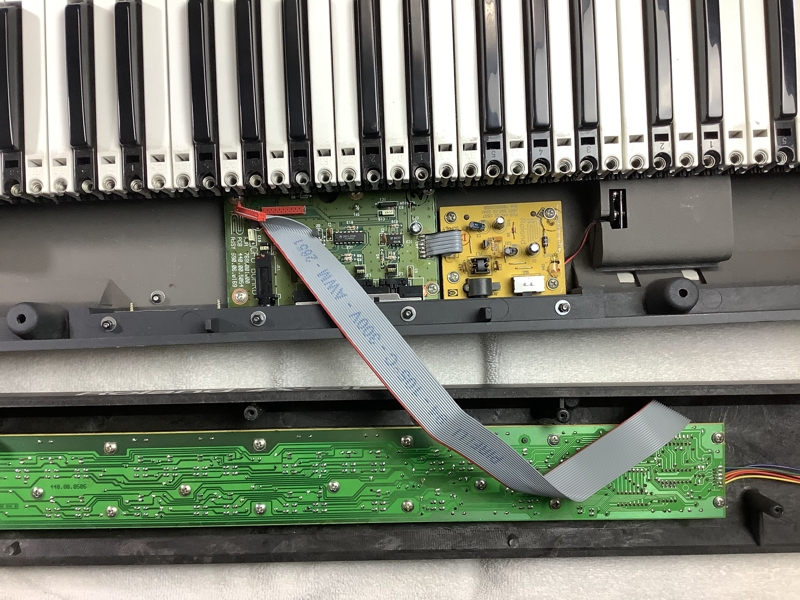
Two
flat cables to key assembly.
You can see the small gray flush nubs and the
larger proud nubs holding the contact membrane to the contact board. Remove the
phillips screws to remove the boards.
This is not discussed or illustrated in
the A-30 Repair Service Notes.
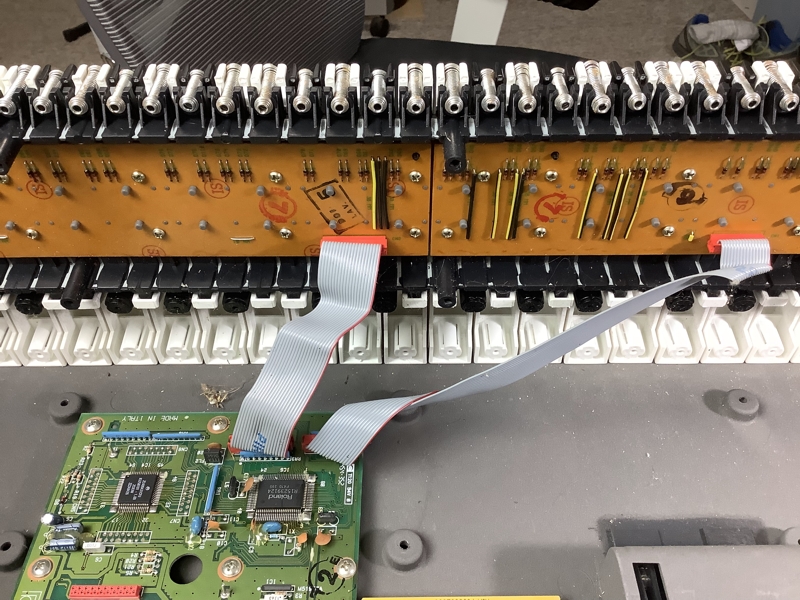
::
MIDI
over WIDI
WIDI Master Virtual MIDI cable eliminator. www.bluetoothmidi.com
Works
dope! Gets rid of MIDI cables. The MIDI cable the studio needs to do away with
is from the key board controller to the MOTU In port. The MOTU 128 number 8 port
is the only device and port configuration that works with these. But, its just
perfect. Plugged them in and they worked. These in their native state
these won't work on the back plane of a MOTU as the in and out ports are
separated. Maybe a 1 ft. female to male cable with the proper connector sizes
would work.
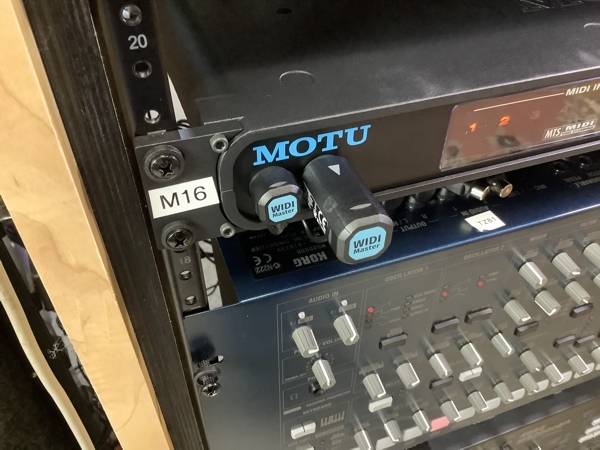
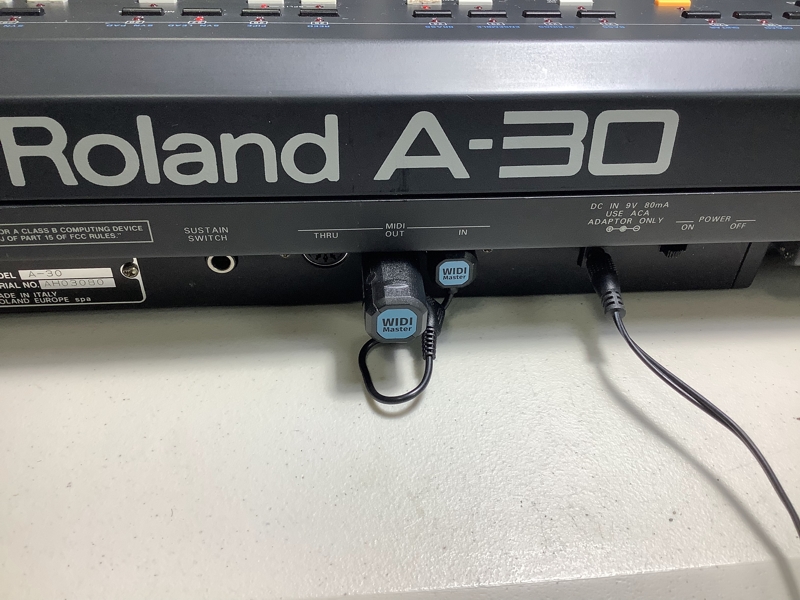
::
Steinberg
Cubase Pro 11
In addition to Cakewalk Steinberg Cubase Pro 11
is being added to the studio. Cubase Pro 11 is an extremely powerful music
DAW. It also is a huge package made by German minds. Its a big bite that
requires much chewing. I'm very excited to use this monster. I purchased the
boxed set.
The box got here. Low and behold- just a thumb
drive. Three hours later the basic software was installed. I'd prefer a cd, dvd,
or bluray.
The next day I downloaded all the VST's that I didn't already have.
About four hours.
Install complete.
This is the list of the default Cubase 11 Pro installation.
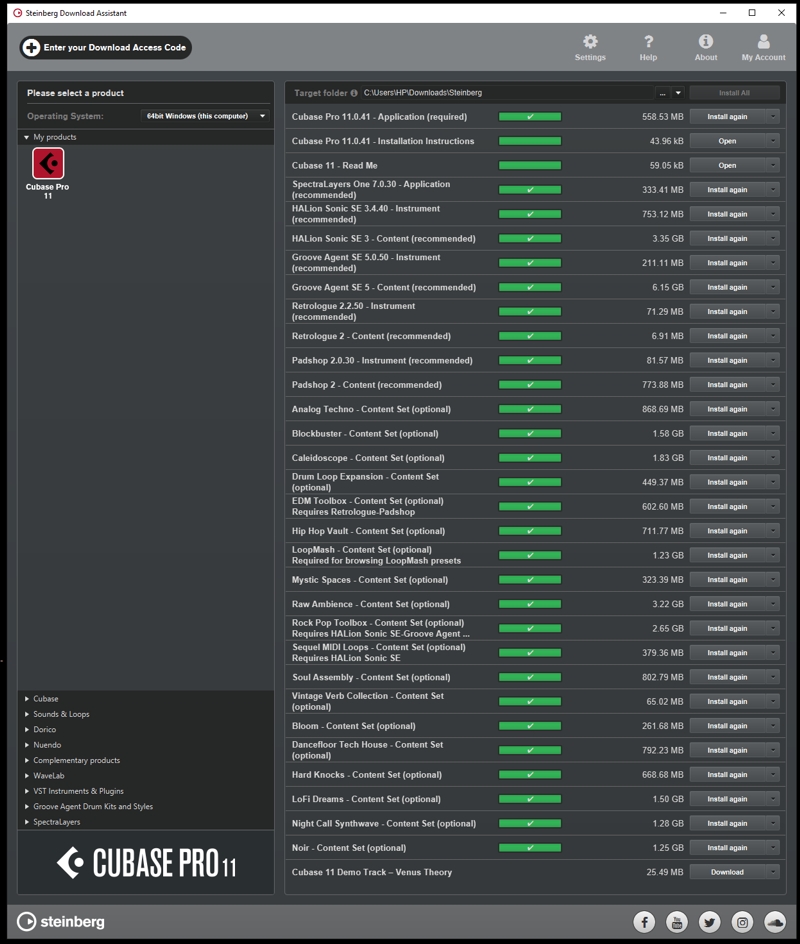
Cubase Pro
requires a driver setup and a Audio Setting configuration. There are three audio
drivers: ASOI4ALL, Generic Low Latency ASOI, Magix 2016.
I tried them all. For
my setup I do the following:
Turn on rack. Re-boot computer. In the Windows 10
Sound settings choose Sony, button OUT on HDMI switch. Select HDMI 2 in monitor
control. Select HDMI 2 then 2 chnl. on Sony.
In Cubase Studio/Studio Settings
choose ASOI4ALL and include HI-Def. In Studio/Audio Settings choose 4.1 and 4.2
for stereo. The USB audio works too. All the MOTU MIDI ports show up without the
driver & audio setup.
:
After launching Cubase web based over the top TV
and services like Netflix won't work.
I will upgrade HALion SE 3 to HALion 6
and to Spectral Layers 8 after I get up and operational.
The MS2000
patch list shows page H as a second F. I modified this list as MS2000B and input
the patch names for the Black. .
:
11/032021
The
Presonus 1824c appears to work. I connected it to a dedicated type 3.1 USB port.
Cubase sees it with the AOSI4ALL driver. The Behringer
Multicom Pro-XL MDX4600 V2s are installed in a rack stand sitting on top of the
four foot wood rack case with the 1824c. Part of the test plan it to verify all
8 channels of the 1824c and using the DA-38 through a TDIF to ADAT converter
routed through the 1824c.All six of the converters will be tested.
-
Apogee
FC-8 no. 1
-
Apogee
FC-8 no. 2
-
MOTU
2408 ( 3 converters; A, B, C)
-
Tascam
IF-TAD
-
I
have power supplies for every component after an order from Ebay for the Tascam.
Patched all the compressor limiters channels to the Presonus 1284c and the
Tascam DA-38.
:
11/21/2021
Project Creep Again More
I pulled the
Proteus /3 from the rack so I could audit the table and build a matching patch
file for Cubase. I find it won't save a user defined voice. My first guess? It
requires a new battery. Working on electronics always involves the secrets of
the manufacturer. Even in their repair or maintenance manuals they leave out
details like how to open the case. It took me over 24 hours to dismantle the
E-MU Proteus /3. Did not want to break it. The soft plastics have a few tool
marks now. It's mine so I can if I want to and I don't like it. I put a voltage meter across the
battery and it reads 0.2v not the 3.0v required. Moving forward with battery
replacement. I ordered a near match battery I may be able to use. Due to the pin
soldering I ordered a new Weller iron with appropriate tips the one I have is
very old and the tip is ragged. It's better sized for bigger soldering
applications. Working on a board, not so much. OK nearly justified. I found two
working p/3's on EBAY. They are running $365 - $465 range now. Between the
battery and the iron I'm at $100. Got the wrong battery
and need the fine solder $140. This better work. I got two batteries so I
can replace the P1 or FX when they die.
See
how to replace a E-MU Proteus battery here.
:
08/2022
SpectraLayers
8
This is an audio design processing application that uses Fast Fourier Transform
and is made by Steinberg. A fast Fourier transform (FFT) is an algorithm that computes the discrete Fourier transform (DFT) of a sequence, or its inverse (IDFT). Fourier analysis converts a signal from its original domain (often time or space) to a representation in the frequency domain and vice versa. The DFT is obtained by decomposing a sequence of values into components of different frequencies.
I
first encountered this algorithm when reading about it in the Bell System Technical
Journal. I had a thirty year subscription with them and their successors.
For
example if you have a noisy audio clip you can sample the noise and then it can
remove the noise. It can remove a voice from a track. Good for karaoke. And it
can do much more.
A short screen capture video of it playing a clip.
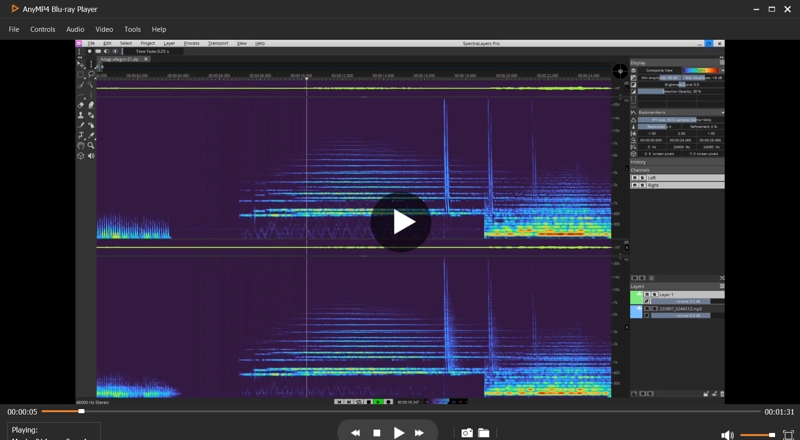
Best New Component.
Remote RF controlled AC switch.
I can now turn the
equipment bays on from the other side of the studio.
3/2023
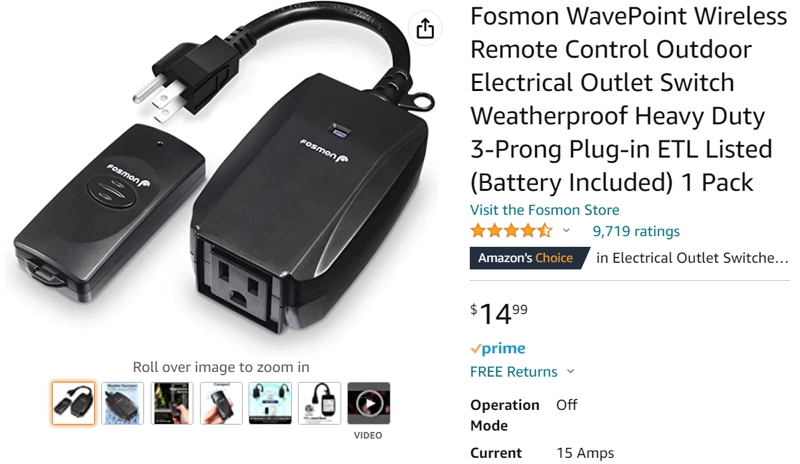
Reboot Synths
EM-U
https://www.emu.com/
Sample Synthesis
Reboot and Battery
Proteus/ 1 32-voice
Proteus FX 32-voice
Proteus 3 World 32 Voice ($125 eBay)
These are real fine rack mounted synthesizers.
Powerful and elegant they support orchestration for most of my compositions.
I like having multiple synths from the same family, it insures sound compatibility
when layering and for voice substitution when I ask for more than one synth
can deliver.
Proteus 2500 ($750 Reverb)
128 voice. Sequencer. 32 Midi sets of 16 channels.



EMU Proteus 3 World Battery Replacement
Alesis
https://www.alesis.com/
MIDIVerb4
Dual 1/3 Octave / Precision Equalizer
MIDIverb-1
Alesis
known for their good service and low cost
products. My first signal processor was an Alesis MIDIverb-1. So when it died I purchased
the Alesis MV4. This device is versatile and very powerful. The LCD went out in 2010. Not good. The MV4 can still be used. I have eye strain
to see the readings sometimes. I found another working MIDIverb-1 ($95 eBay) this 16 bit,
preset, effects sound processor only has a 10kHz bandwidth. It only works
on one side. There is a fix for that but I don't know how. It still has a place-
say sound from the Yamaha Txz81z through one side of the MV1 to a Korg MS2000 as
a wave form or controller. This
combination provides a edgy sound quality that is useful. The Alesis
EQ-230 a 1/3 octave graphic equalizer is a helper used to balance out the
monitoring system. I use the Radio Shack SPL meter and prepare a 3d graph of the
room sampling 20 to 20,000 Hz in 1' squares in the listening zone. I then use
the equalizer to balance out the fundamental and harmonic resonates in the
sweet spot. It's a lot of work but worth it. Headphones are fine but not enough
for me always.
The MV4 was real fine when it was new. It still works but some settings have
more noise than when it was new. Mastering inside the computer will allow the
use of software effects so this should be optimal and noise free. I'm not there
yet. In the meantime, I found another New Old Stock MV4. Then I got three more.
Front and rear 1402 mixers sidechain 1 & 2.
,

Q49
MIDI Controller
It's nice to have a smaller keyboard
especially when I'm working on voicing a synth a nearby controller is handy. I
got this to update from the Fatar by including mod wheels and velocity sensitive
keys. Because I use MIDI not USB, I require the DC transformer (wall wart). The
wall wart doesn't come with the keyboard. Multiple emails to Alesis went un
answered. They spec the DC volts, amps and barrel connector outside diameter,
they do not spec the inside diameter. I'll ended up ordering a 9vDC 500ma
transformer on line and splicing in a barrel connector that fit as they used a
larger than normal pin. This pin size is normally only used on larger voltage
transformers. The day in the life of a musician trying to work with a
vintage system.

Radio Shack Sound Pressure Level Meter
I use
this device to measure the audio resonance of a room related to a tonic note.
After locating the speakers measurements are made throughout the room. The
results relate to the frequency, room dimensions, room’s surface types and,
acoustical properties. I use this SPL
dB
tool to
map out locations in the room where the louder and lowest dB’s (volumes) are.
For example; a rectilinear room having surfaces of low absorptive will result
in a very symmetrical x-y-z grid of alternating low and high dB’s. At
this point listening locations can be balanced and re-measured until you get the
best results.

Yamaha
https://www.yamaha.com/
FM Synthesis
FB-01 Doesn't Stink
FB-01 8 voice. No longer supported
This is the first Yamaha MIDI rack synth I owned.
Purchased it at West LA Music in 1986. It is over 30 years old and still fully functioning! This is a ½ wide
shelf unit and not very versatile. But, these older FM synths can have
a warm, fat, or fuzzy sound that can cut through a mix. These synths can round
out the sterile quality of other digital synths by adding a sound quality color to the audio palette. Alone the
FB-01 sounds warm fuzzy and somewhat thick but when used in contrast with PCM synths
it becomes fuller and richer like a single red brush stroke on a busy oil
painting. These FM synths can produce some fat bass.

:
MODX6+
Yamaha
MODX6+ is a great synth.
I'm using the On-Stage KSP100 Universal Keyboard Sustain Pedal
with the Yamaha because of the polarity switch.
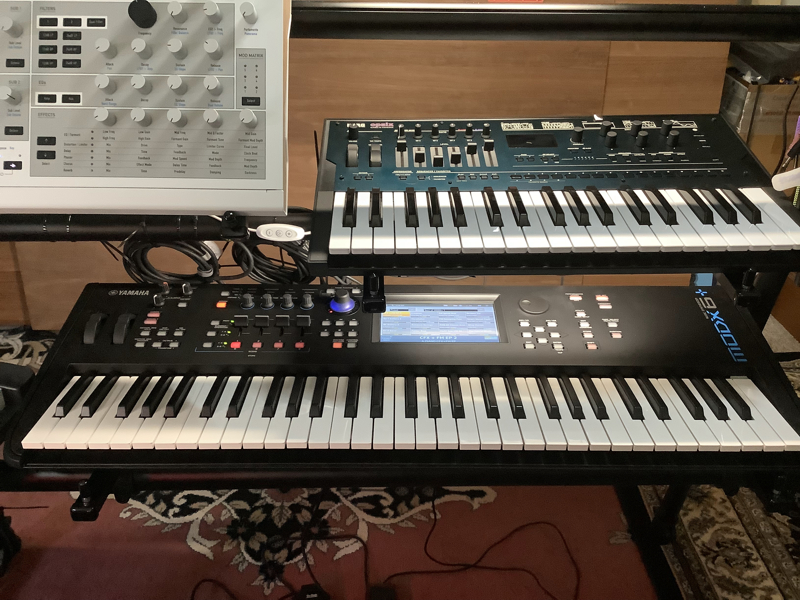
TX81Z 8
voice
Page 1
Page 2
Retired 07/2023. It works but a cap is going out and I want to preserve it
for a repair effort.
I
added this TX81Z FM synthesizer to my lineup in 2012. It is a full width 1U high 8 voice
FM synth that has 128 ROM slots and 32 RAM slots. I can't wait to use the Unisyn Patch Editor and Librarian
to sculpt some new sounds from this baby. Its a better version of the FB-01.
($135 eBay)

Click on the picture to see full size
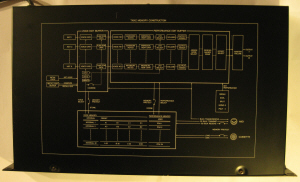
:
Korg
https://www.korg.com/
Multi Sampled (PCM) Waveform Synthesis (AI2
synthesis), analog modeling, and analog.
:
X5DR 64 voice
NS5R 64 voice
Korg MS2000R Rack Synth
4 voice
Korg MS2000BR Rack Synth
4 voice
Korg MS-20M monophonic
SQ-1 Sequencer.
Korg OPSIX
:
1212 I/O
:
Well, where do I start? Many years ago I had a MiniKorg
700s. This was my first Korg. More recently, the first time I heard
the X5DR I knew I had to have it.. The Korg MS2000R
(rack mountable) is a used virtual analog synthesizer that I obtained in early 2012.
Changing the Battery
in the X5DR


When the NS5R came out I was first in line. Remember I like to have multiple
synths from the same family for layering and substitution. If you could only get
one synth I would suggest the NS5R. This fully programmable 64 voice polyphonic
synth just won't stop giving up new and interesting sounds for your music.
Version information boot method; Hold down both PRAM buttons when turning on.
If your LCD gets set so bright or dim it can't be read what do you do? You can't
see the screen to navigate through the menu to adjust it!
Press the three bottom buttons simultaneously (MUTE, DISP & EXIT) and turn on.

Virtual Analog Synthesis
The Korg MS2000R
(rack mountable) is a used virtual analog synthesizer that I obtained in early .2012.
Real cool. I like the way this sounds better than the BR. I have been going through this testing each controller.
I find the BANK/OCTAVE DOWN and the KEYBOARD switches don't work. I'll test
later to see if I can affect these functions via MIDI commands.($300 eBay)
Korg MS2000 Service Manual
Click on the picture to see full size
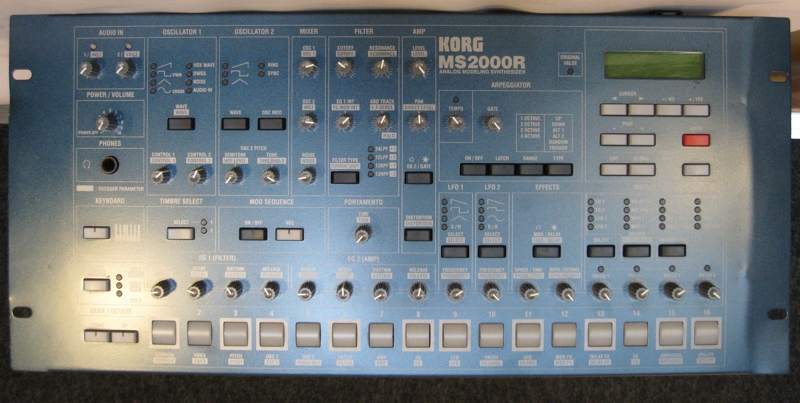

:
Korg MS2000BR
The MS2000BR was added in late 2014 to supplement the first one. It broke
and I purchased another on eBay in 2019.
Listen as I move through the knobs
with a patch.

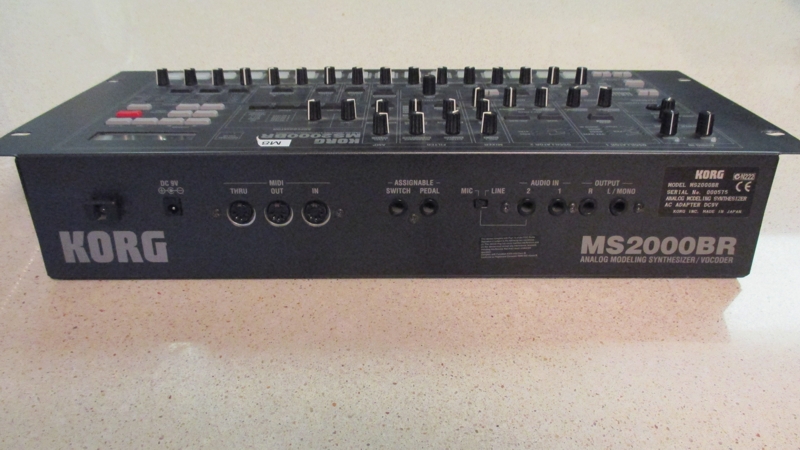
Korg MS-20M + SQ-1
This is a true analog synthesizer. Monophonic. The SQ-1 sequencer is CV and the
MS-20M can use MIDI note on and off commands.
Korg products web page.
Korg SQ-1 Instructions I assembled it
in a couple of hours. Lots of nuts. It takes a 12mm nut driver- not in the
instructions. I am considering tapping out the mod locations off the
motherboard. When I connected the USB from The
Tyan Tiger to the SQ-1 an interesting thing
happened. Even with the MS-20M and the SQ-1 turned off the Tyan creates some
processor activity or video activity sounds that move through the USB to the
mixer. The MS-20M is connected to the Alesis MV-4 with a setting that only takes
a little sound to excite it.
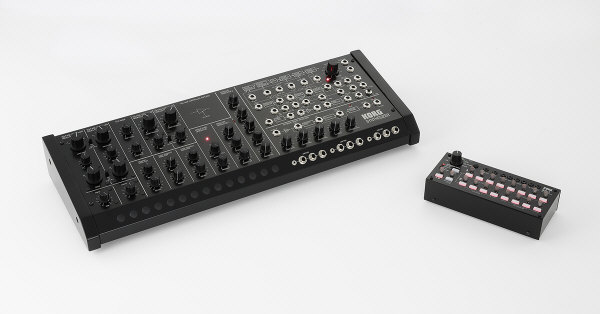
Here I have painted white latex paint with a two horsehair
brush on to the indents of the pitch controllers of the SQ-1. I think they read
a lot better… at least I can now see where they are pointed to because
before I could not. This paint shows up well when they are lit-up red or not. A
real improvement.
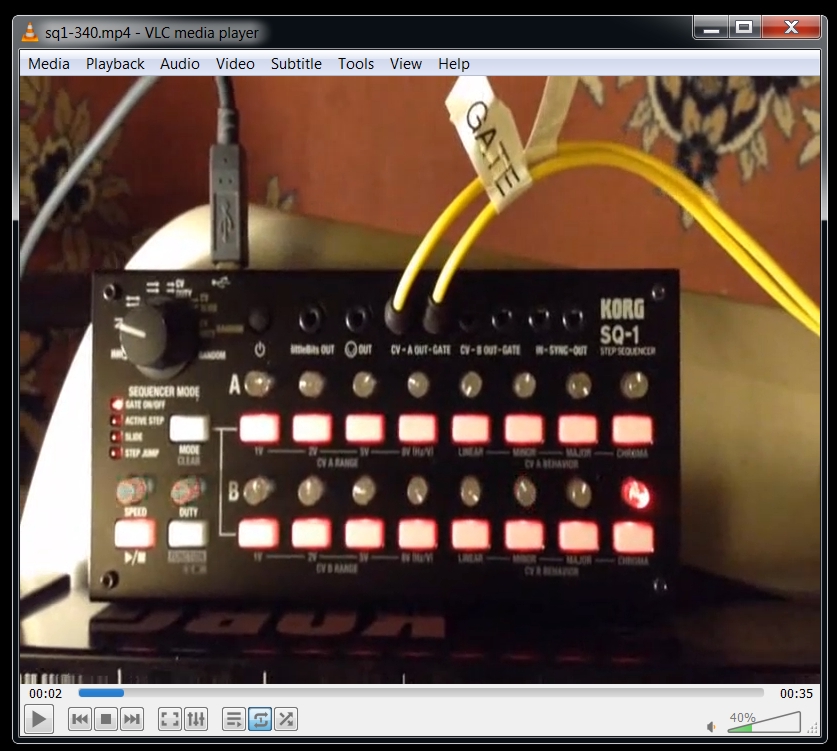
Listen to the Korg MS20M PURRR.
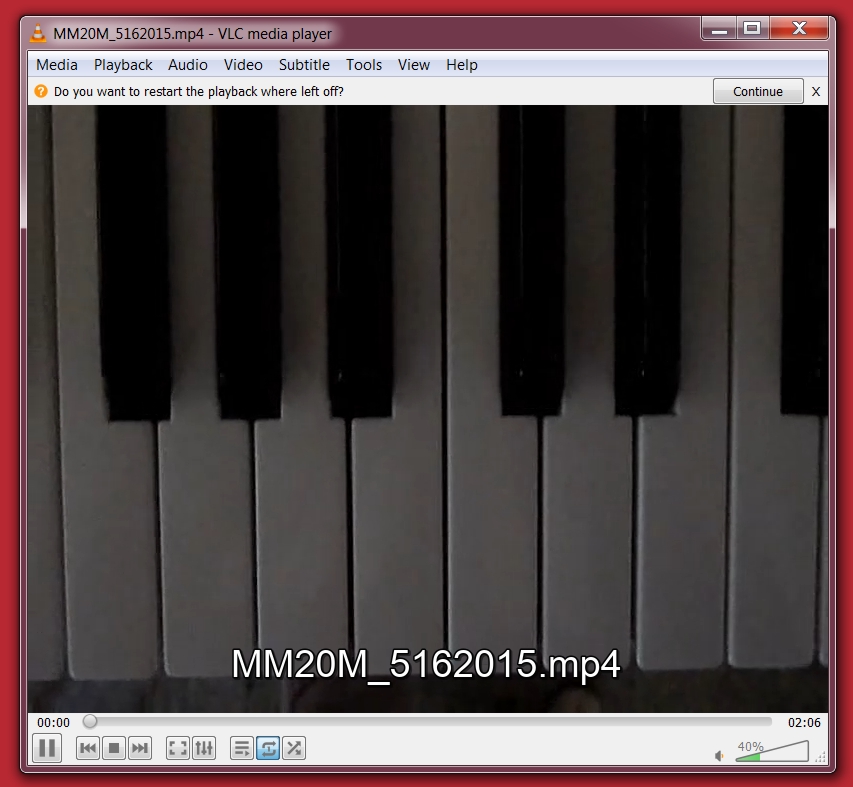
Korg OPSIX
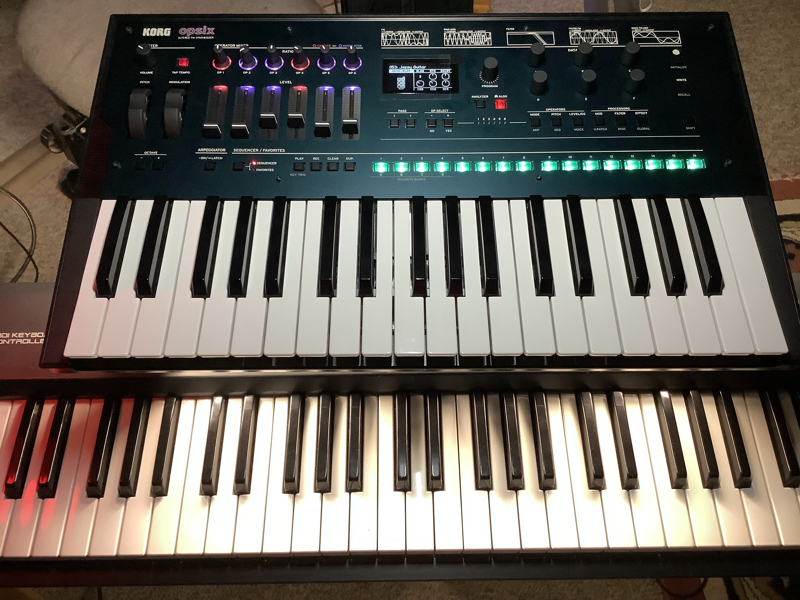
Korg 1212I/O
The 1212I/0 is a great piece of hardware bringing 8 tracks into the
computer without the signal to noise ratio issues at the electrical connections
of the micro buss interface of
the computer as I use the ADAT optical cable. The
Korg 1212I/O lives in the Tyan Tiger 100 Pentium
Windows 98SE.
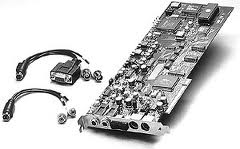
Waldorf Micro Q
2000
https://www.waldorfmusic.de
Virtual Analog and Waveform Synthesis
Polyphony - 25 voices, 3. Oscillators - 5
oscillators per voice (Pulse with Pulse Width Modulation, Saw tooth, Triangle,
Sine, 2 wavetables with 128 waves each and sub-oscillator per alt-wave); Noise
generator. Control - MIDI In/Out/Thru (16 parts).
($450 eBay)

The Waldorf's factory
samples
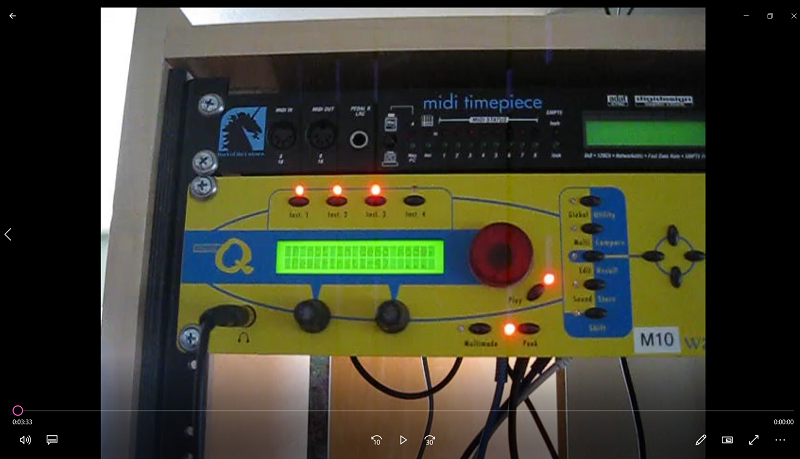
Waldorf Microwave XT
1998
Waldorf Microwave 2 Version 2.09 Compiled Wed April 1 15:05:03 GMT 1998.
Waldorf
Two wavetable oscillators plus noise generator and ring modulator. Oscillator
Sync and FM.10-note polyphonic, 8-part multitimbral.256 User Patches, 128 Multi
setups. The arpeggiator forms part of patch meaning up to 8 simultaneous
arpeggiators can run in multi mode. Arpeggiator and LFOs can sync to MIDI clock.
Two filters with a total of 12 filter types. DSP effects -- the first three parts
in a multi performance can use their full effects settings, the remainder are
limited to chorus. External signal input to filters/effects.65 wavetables plus
32 user wavetables.44 knobs, 9 switches, 2 x 40 character display, shift key,
alpha dial. All major parameters have a dedicated MIDI controller numbers. Knobs
send MIDI controllers. 5 rack units.
($700 eBay)
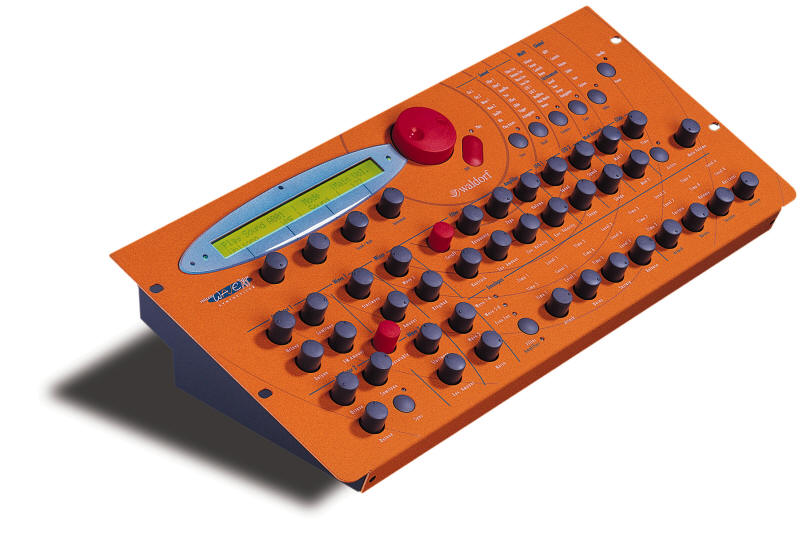
Mark of the Unicorn
https://www.motu.com/
Timing is everything.
2021 Updated MIDI to USB via Win 10 replacing the parallel connection from a
Win 98 system.
The October 2023 the studio has one Express XT and two Express 128s.
The system crashes occasionally when the sort order of the MOTU devices
scramble. The first and second scramble took 8 hours to repair. This was before
I figured out what was really happening. Now I go over to the hub and
swamp the two 128 USB cables, clean up a few In & Out channels in Cakewalk,
and the system is up and running. My guess is Windows 11 is the bad actor. Its a
real PITA. Maybe three Express XTs would be more stable.
MOTU MIDI Express XT
Eight MIDI channels all channels appear on the back except MIDI In chnl. 8
which appears on the front with a MIDI Out chnl 8 out. The back plane has the 15
MIDI connectors, USB type B, SMPTE, In and Out and AC.

MOTU MIDI Express 128
Eight MIDI channels all channels appear on the back except MIDI In chnl. 8
both In and Out which appear on the front and back, USB type B, no other
connections. This component is powered via USB. I placed a powering hub in the
rack for these two USB type B connectors.

:
Retired MOTU
MTPAV
BUGS, ROM, and Battery
This is an eight port MIDI in/out hub that connects
to the computer via a parallel interface cable. The SMPTE, ADAT, video, or audio
click coding and sync
capabilities are a necessity. With two keyboards and
seven MIDI devices this device is working at max, necessitating daisy chaining of
some MIDI devices. Acting as my hub controller, my setup needs to be flexible. I
can use the
tremendous flexibility this device has to offer.
I need it. Mark of the Unicorn is on top of the driver issues for all new
OS releases. I know this investment will be useable for many years. There is no
direct support of the model I have. I
have the model with the RS-232 parallel printer interface. 02/01/2012: I
acquired a second MTP AV parallel MIDI hub. With these two devices
networked together the rack will be capable of interfacing with 16 MIDI devices.
This will be much better and easier to use than dealing all the problems that
happen when MIDI devices are daisy chained. 04/01/2012- Ordered ROM chip update
from MOTU I will replace the CR2032 batteries at the same time because these
won't save any configuration settings. It now looks like I can't network two of
these and use W98 as the OS due a W98 limitation. So fine, I could just up grade
the computer (dual boot) to XP. But then the Cakewalk won't work. The Pandora's
Box scenario that I'm trying to avoid will begin to happen resulting in me
having to upgrade everything. I'm trying to stay vintage and limit investment
and write off costs. So, I'll tinker at the upgrade but 99% of my effort will be
used to reconfigure the MIDI to share MIDI ports between the devices. It will be
a little harder to configure and will probably result in some limitations but
nothing I can't handle. Without a doubt, I'll end up thoroughly understanding
this aspect of these synthesizers.


2408 MK1
Found this document through the Wayback
Machine
2 page spec
The 2408 is not in use. This may be compatible with the Presonus 1824C as a DAC
to ADAT path. Will it work passively without drivers? ... testing required, fun.
Its a backup that uses Firewire has a Clock connecter as well as SMPTE In &
Out and three 25 pin connectors for cabling to a patch panel, MIDI mixer, or
whatever.

:
Behringer
https://www.behringer.com/EN/Home.aspx
Protector ( no support)
MDX 1800
As the Tascam DA-38 is a digital recorder, its AD
converters can't saturate and absorb extra energy like an analog tape recorder
can. Instead these AD devices clip and screech making the recording unusable.
A dB limiter must be inline between the mixer and the digital tape recorder
to prevent this and is an absolute necessity in the digital recording realm.
I like to use the limiter to control spikes while allowing a very hot recording.
The Protector is an eight channel limiter that is cabled channel for channel
with the eight track DA-38.

Mackie
https://www.mackie.com/
1402-VLZ3 (2012)
This mixer is going to
make my recordings clearer, cleaner, more accurate, and provide more versatility
and options.
Click on the picture to see full size


Mackie
https://www.mackie.com/
This Mackie 1402VLZ was purchased through EBAY 11/2014. It is very quiet and works well.
Click on the picture to see full size


Tascam
https://www.tascam.com/
DA-38
MMC-38 MTC/SMPTE out, MMC control - DA-38
Tascam DA-38 Owners Manual
Tascam IF-TAD Manual
lightpipewordclock
DA-88 FAQ
Tascam DA-38 Recording Setup Checklist
The DA-38 is an 8 track 16 bit CD quality digital
recorder. When linked up with the MMC-38 the recorder can sync up with
other devices. I set Cakewalk to external SIMPTE Sync and then can mix
my six synths down to two tracks and do this four times without having
to bounce tracks. This allows a setup, say for a trap set, where each drum
and cymbal has its own mixer channel. If I forward Cakewalk to measure 30
the DA-38 forwards to the same position and vise versa.

The MMC-38 is designed to offer MIDI control over the DA-38. This will convert
MMC to DTRS transport commands, and convert tape time (ABS) to MTC and SMPTE
time code. This is ideal for giving sequencers, or basic digital consoles
transport control over the DA-38, and synchronizing MIDI equipment.


The picture below shows settings as 24 FPS and ID#1 and MIDI connection with
MMC.

IF-TAD
Tascam IF-TAD Manual


Tascam DR-40X
Great little digital tape recorder. Records up to 4 channels,
has phantom power, and can work off of USB buss power as well as three AA
batteries.

Crown Audio
https://www.crownaudio.com/
Crown XLi 800 Power Amp
300 Watts of Neighborhood Disruptive
Power.




Data Sheet
Owners
Manual
After The Crown DC150 blew out the
studio monitors and fried, I needed a new power amp & mix speakers. This is the one I picked. I
hope it will serve me well. It puts out more power than the speakers can handle.
So it will never be turned up above the mid mark of 10dB of attenuation.

Attenuation expressed in
decibels of relative power. A 3dB pad reduces power to one half, 6dB to one
fourth, 10dB to one tenth, 20dB to one hundredth, 30dB to one thousandth and so
on. For voltage you double the dB's so for example 6dB is half in voltage.
:
More Really Great Sound
These are great speakers.
JBL G 500
:
SPEAKERS
Yamaha NS-6490 three way crossover speakers.
These are passive bookcase sized speakers. For day to day working I need a well
balanced speaker size like these to limit hearing exhaustion. The range of these
speakers is 45 Hz - 23 kHz. The energy rolls off in the lower frequency naturally so the mind
can estimate it's true force. The high end does the same but at a slower roll
off rate. These provide really clear highs. Enough to hear what is going on above 9kHz well but not cause fatigue.
That's an 8" low range speaker. Most bookcase are 5". These are good low impact work speakers.
I have never been dissatisfied with Yamaha anything. That said, I
almost never listen to these with out the subwoofers. Add a of subwoofer to the
Yamaha NS-6490's 8" Cone Woofer, 4" Cone Mid-Range, 7/8" Balanced Dome Tweeter
and you have a real fine 4-way crossover sound system.


https://usa.yamaha.com/products/audio-visual/speaker-systems/home-speaker-systems/ns-6490/
These are clear and balanced. All I can say is WOW. Great sound.
:
Speaker Wiring
:
From
https://www.barryrudolph.com/greg/fuse.html
by Greg Loskorn

Sony Subwoofer SA W2500
Sub woofers are great like a cigar in a non-Freudian way. As in the way a cigar
is only great if you are the one smoking it! So are subwoofers great only if it
is connected to your sound system. Those big subwoofer systems in cars playing a
LF bass line; my first thought is I don't like it cause its some other
person's sound system. At least most the kids in the neighborhood won't get run
over because they can hear them coming. I love working in the lows and these
allow me to hear what I'm doing. The oldest of the two SA W2500 burned out
06/15/2023 probably due to the coils. I'll do repairs later. I replaced it with
the newer model Sony SACS0 10". Exact same size and they moved the green
LED pilot to the rear where it is much less user friendly so they could use a
square front grill that covers the entire front.

:
The studio is a rectangular room with a half-bath in one corner. I've said this
before; small corner rooms act as base traps. I use the bass trap to monitor certain
aspects of the bass frequencies in a mix. The best way to use a stereo set of subs in a
rectangular room is to have one facing forward and one
backwards where
they are not in the centroid area of the room. This allows the sound from the
sub facing the
wall to have to reflect off that wall so it reaches the other speaker traveling
a longer distance than the other sub's path length to it. This reduces the wave canceling effect that occurs when
the sound paths are of the same length. So it works for both subs.
This has no effect on resonating and canceling zones in a room. It just stops
frequency cancellation at the speaker cones. Try it, the low frequency gets much
more clear and precise.
A minimal 49 key keyboard. No after
touch, mod wheels, or MIDI in. It is very fast and transmits velocity info. A
real keeper.
Except the MIDI connector is loose and can't be connected to reliably. Its off
line.



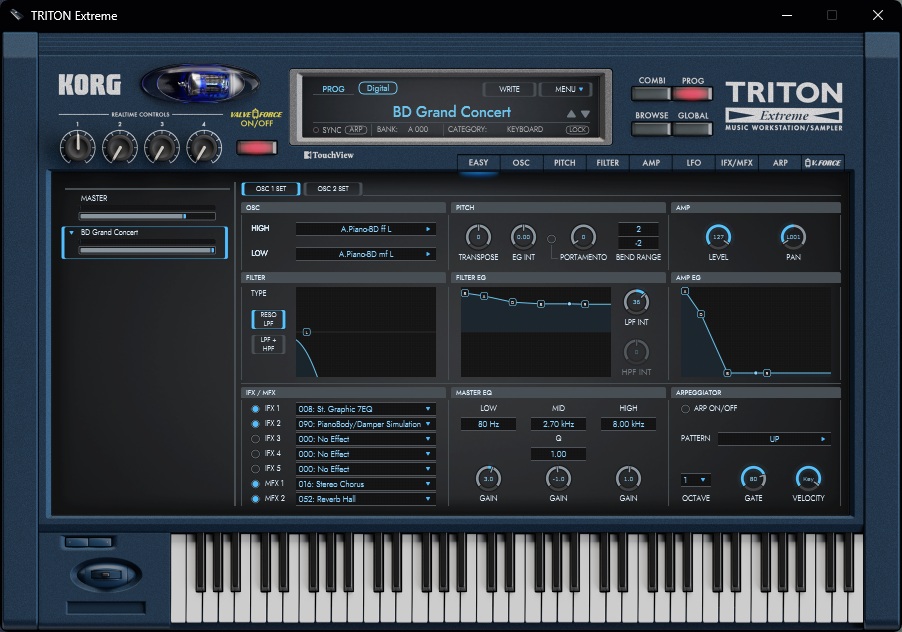
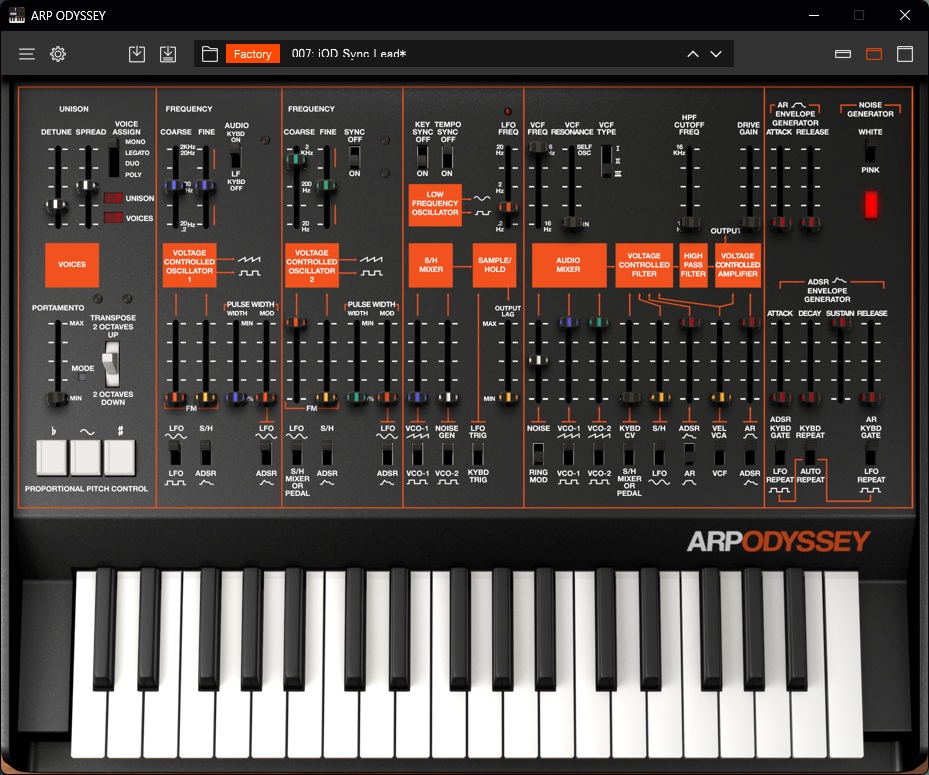
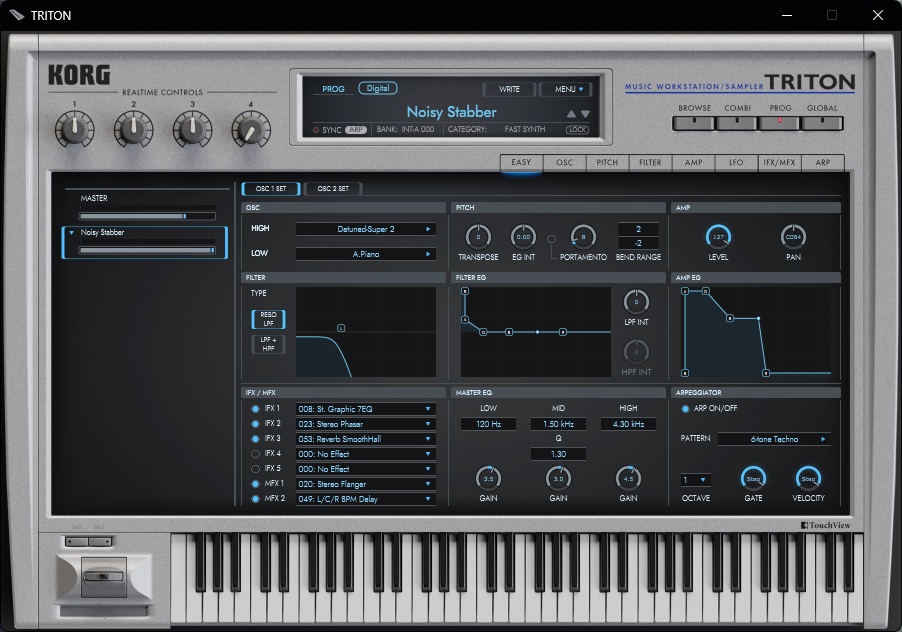
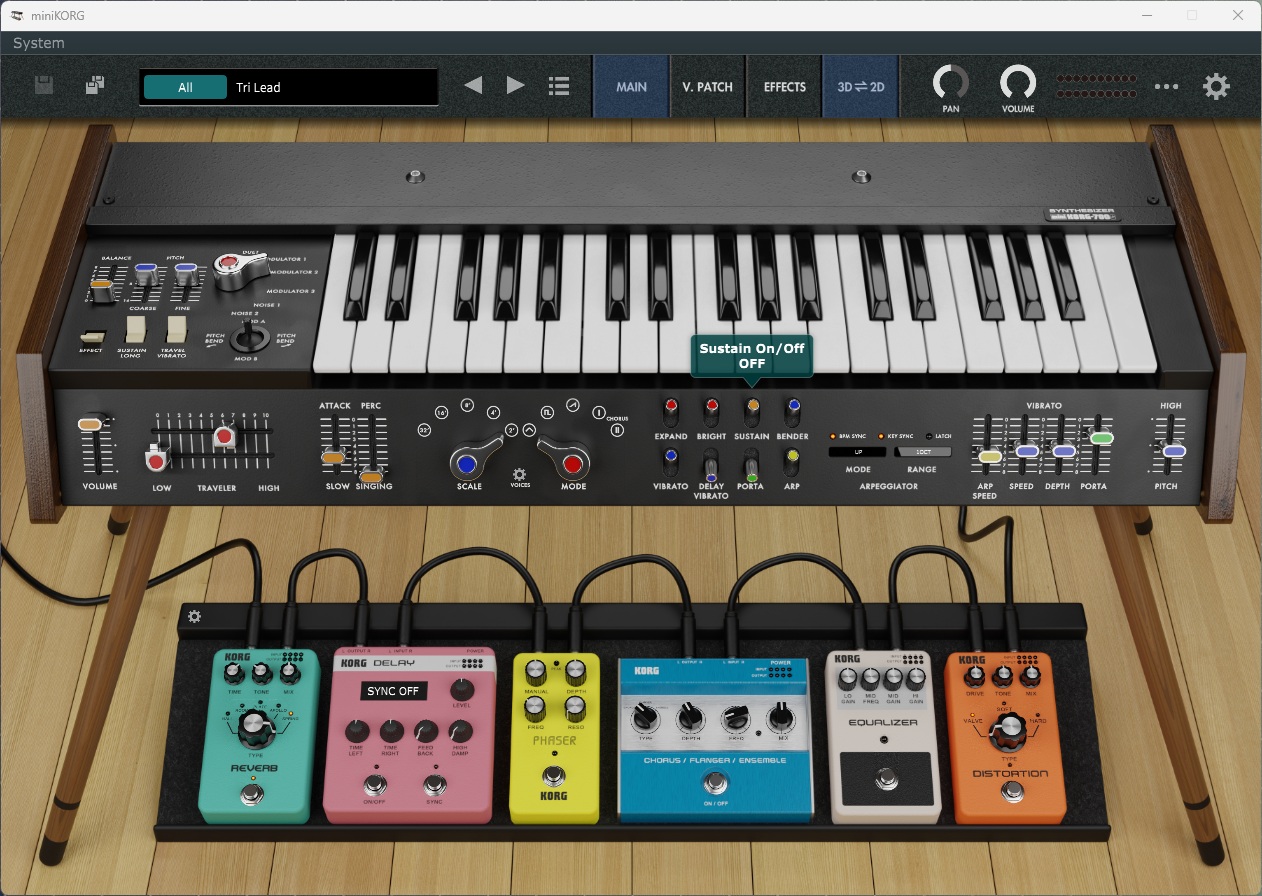
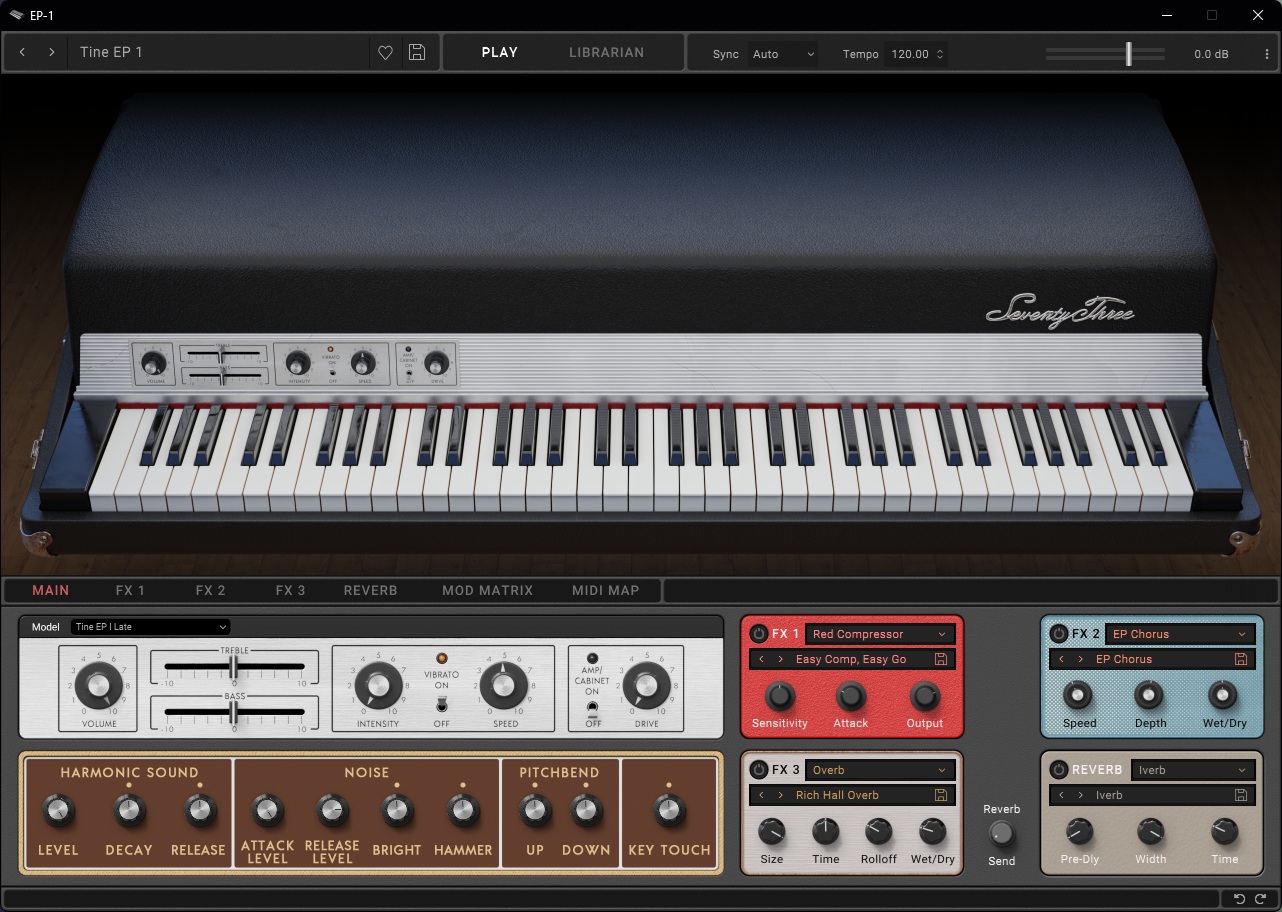
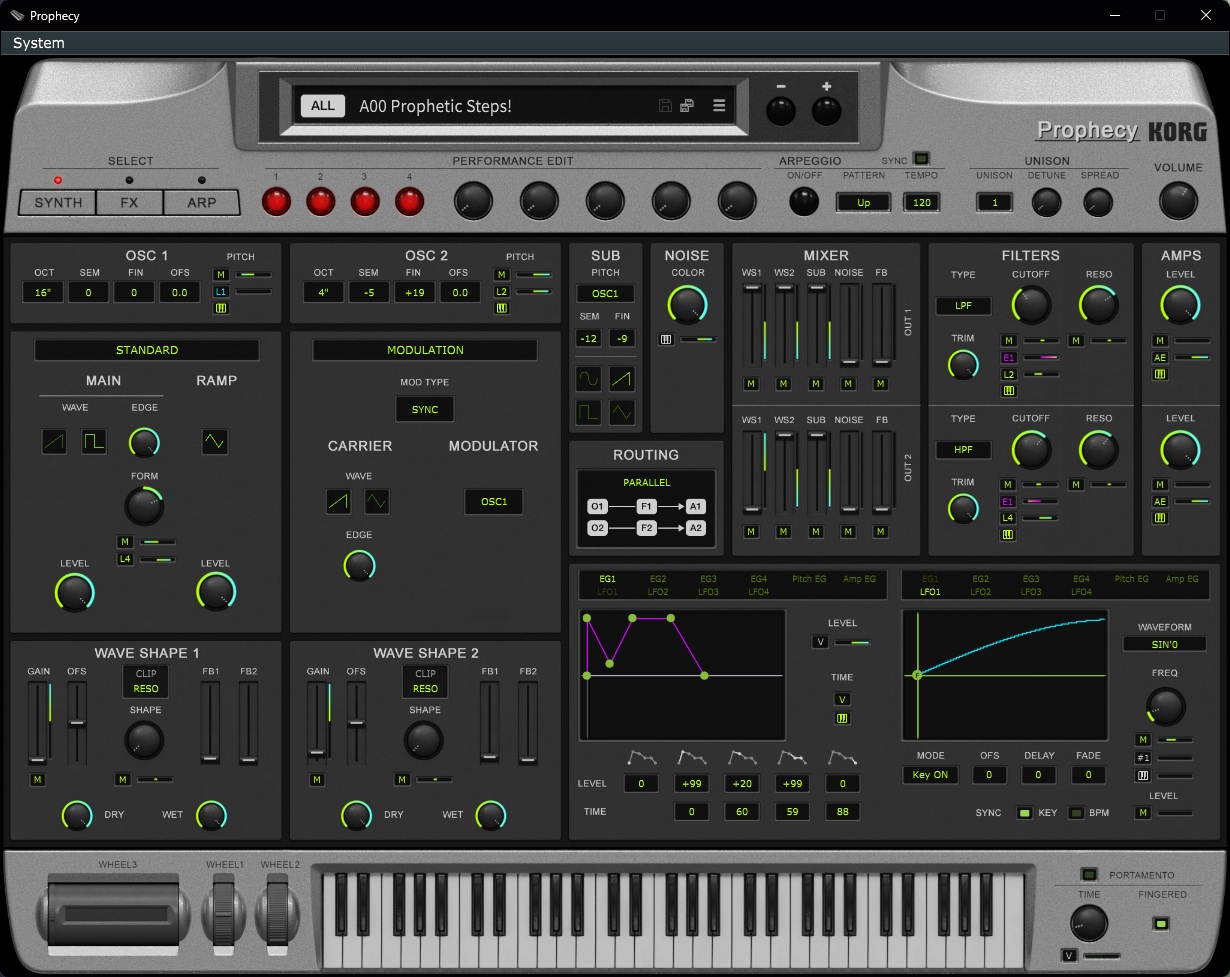
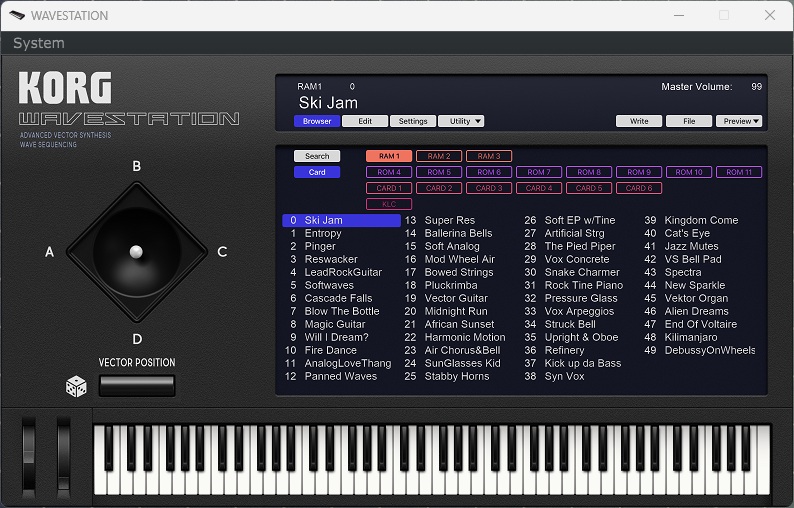
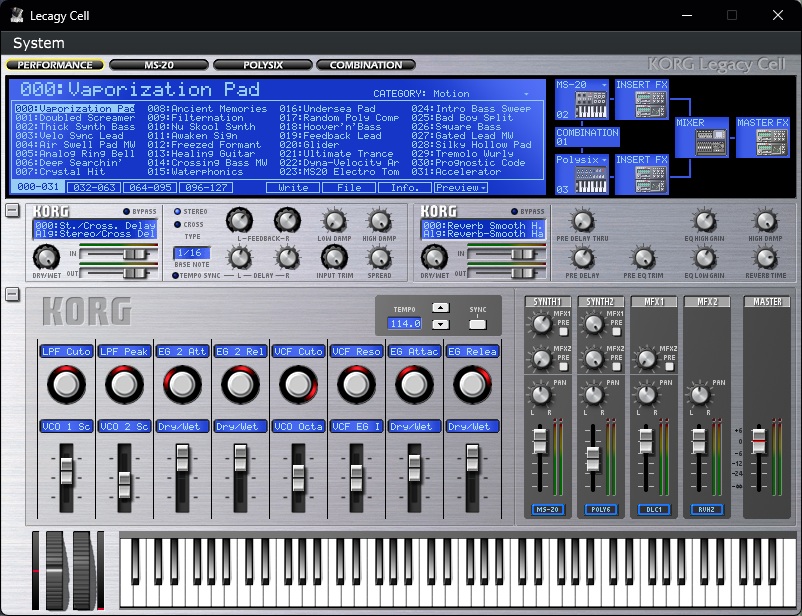
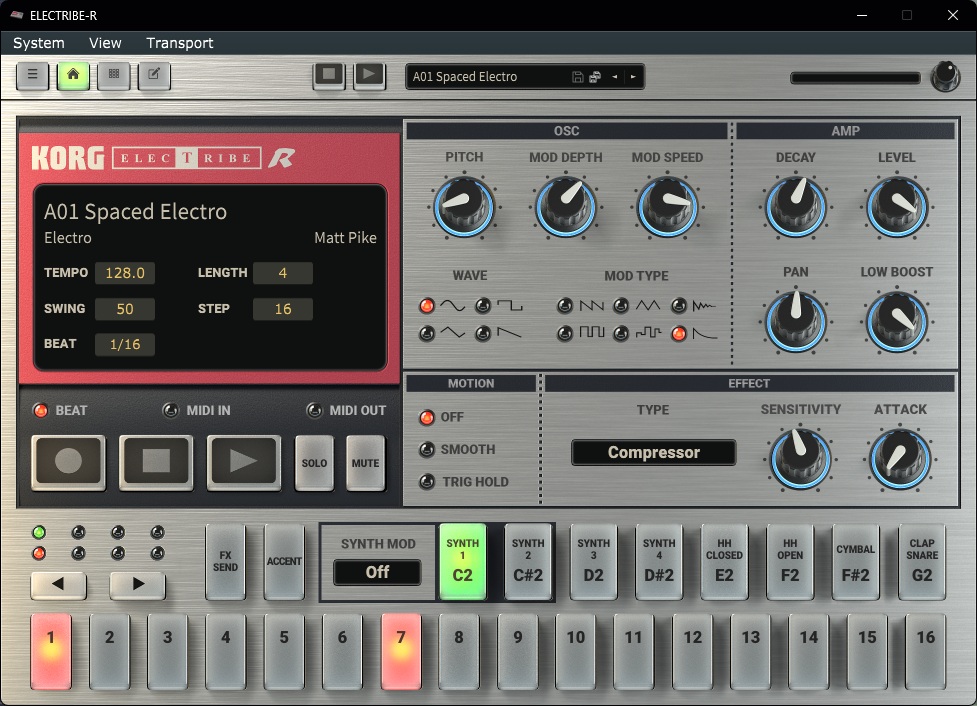
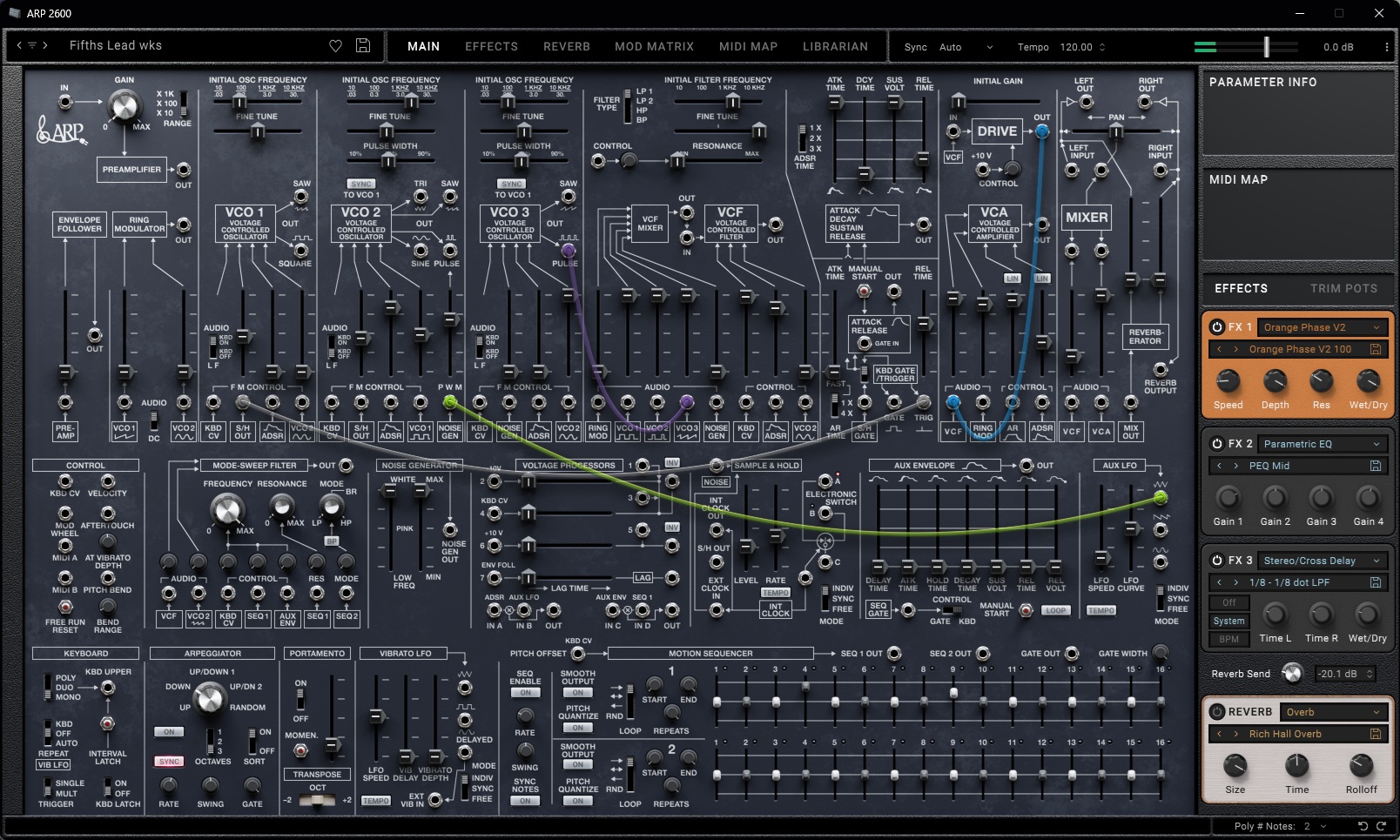
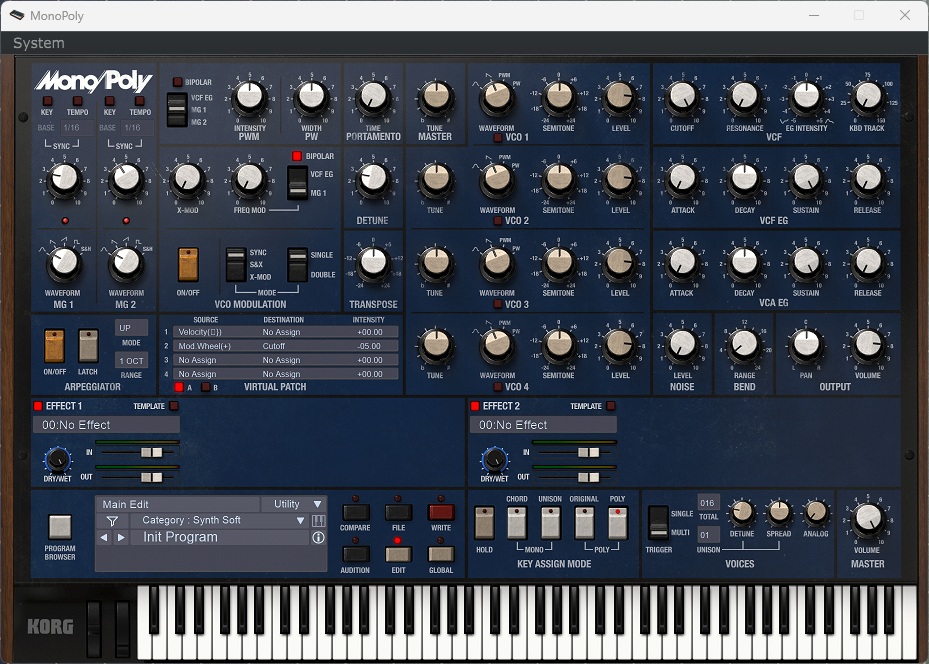
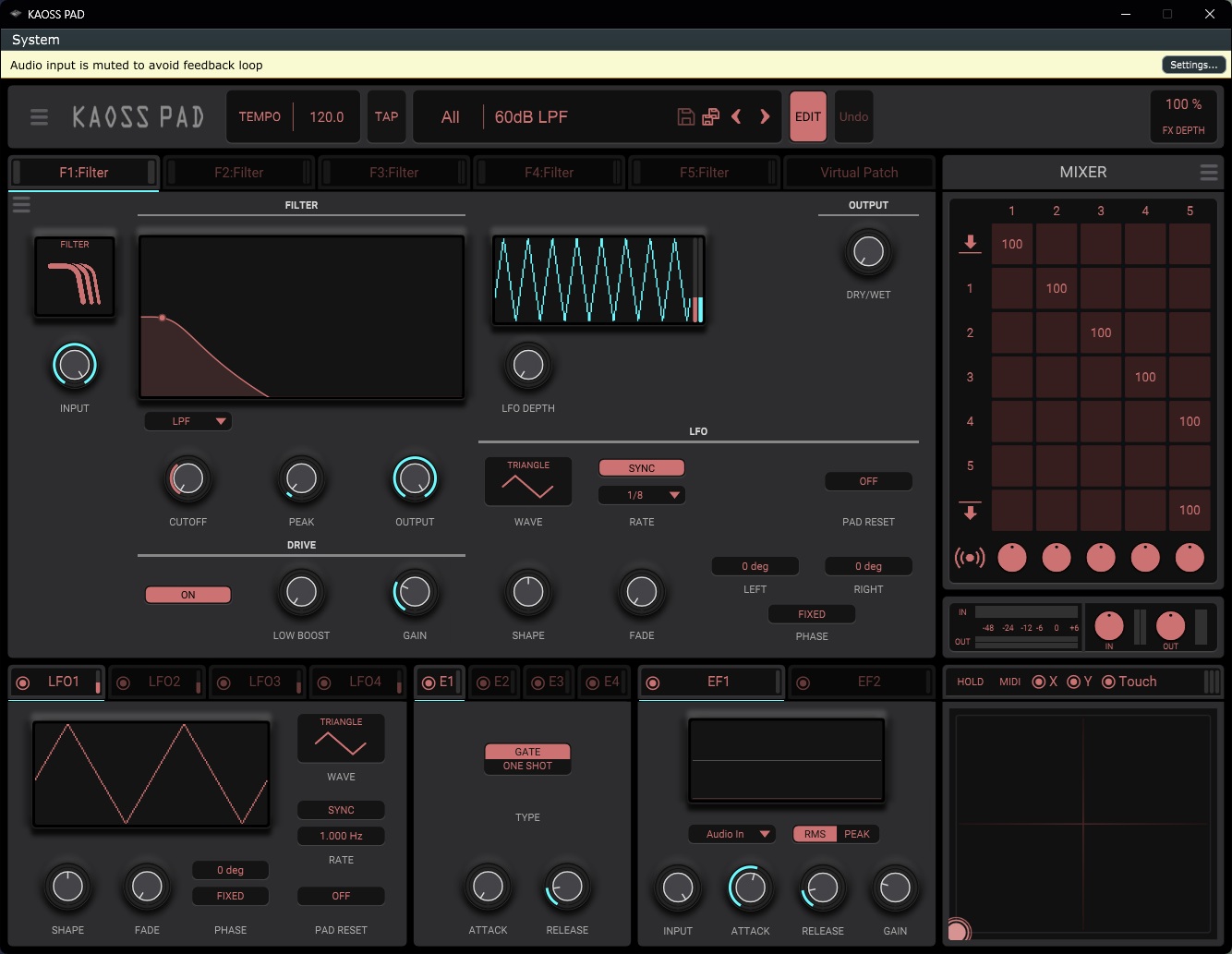
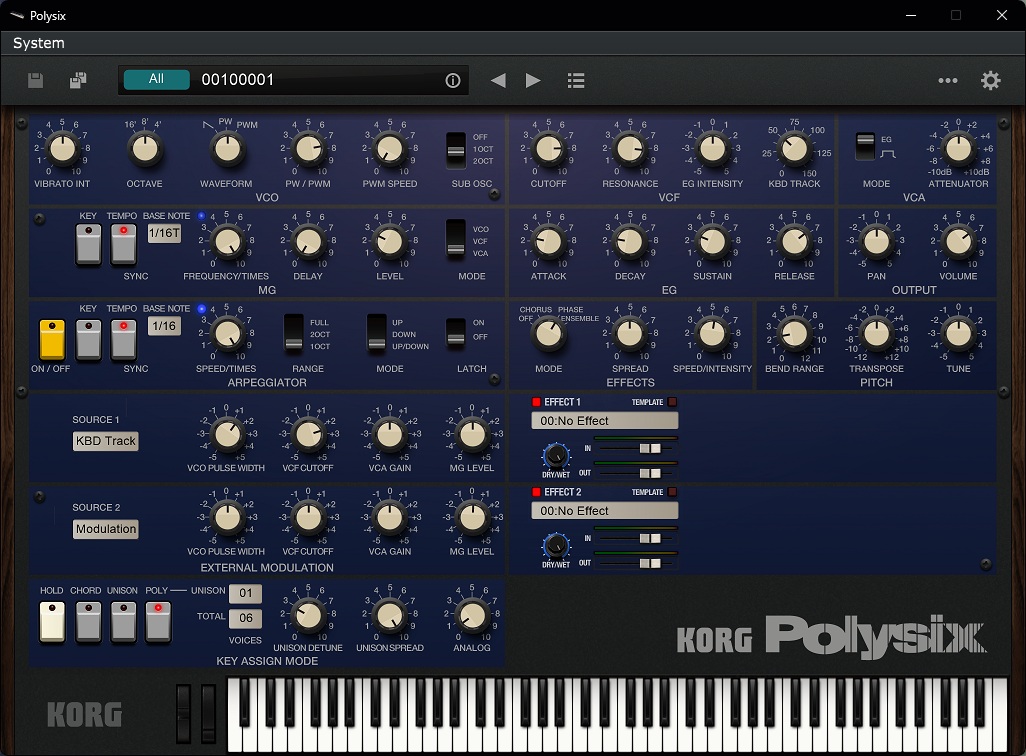
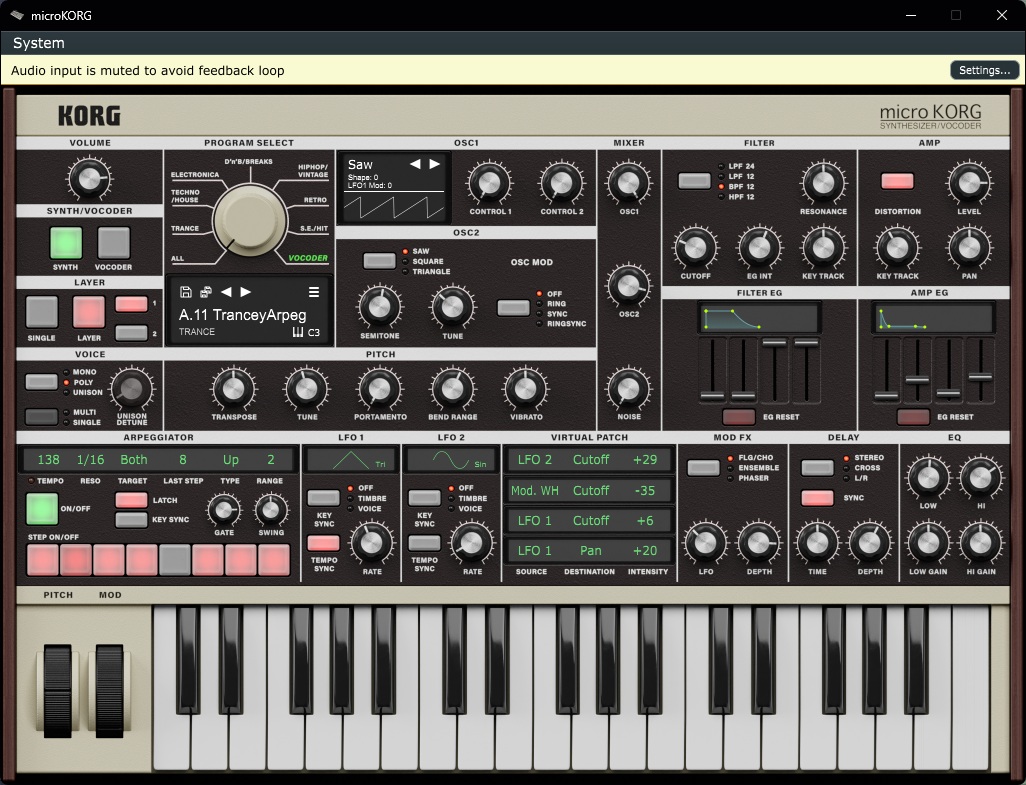
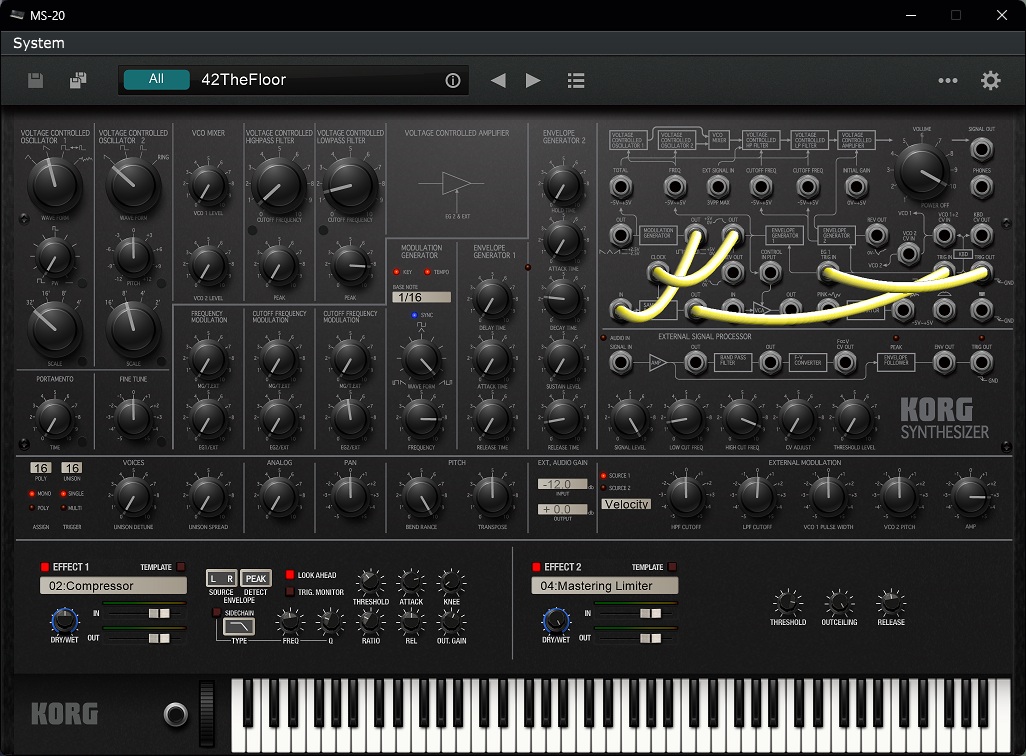
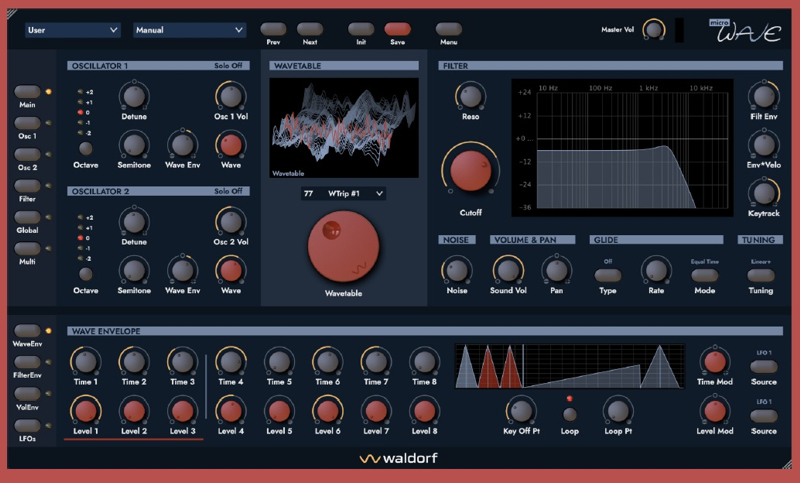
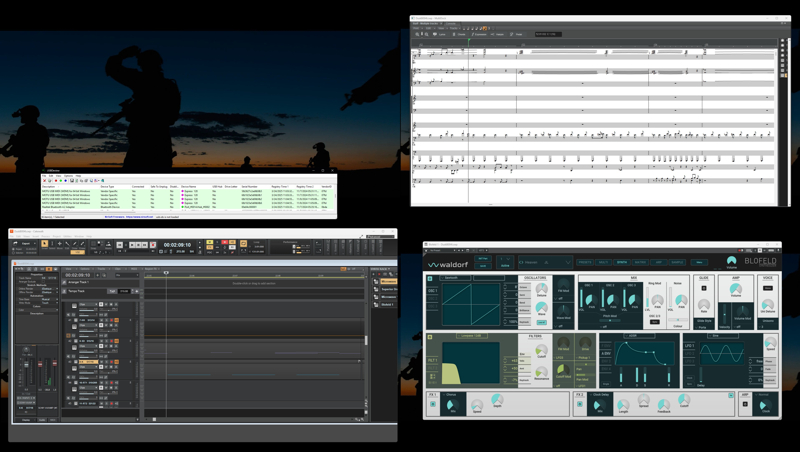
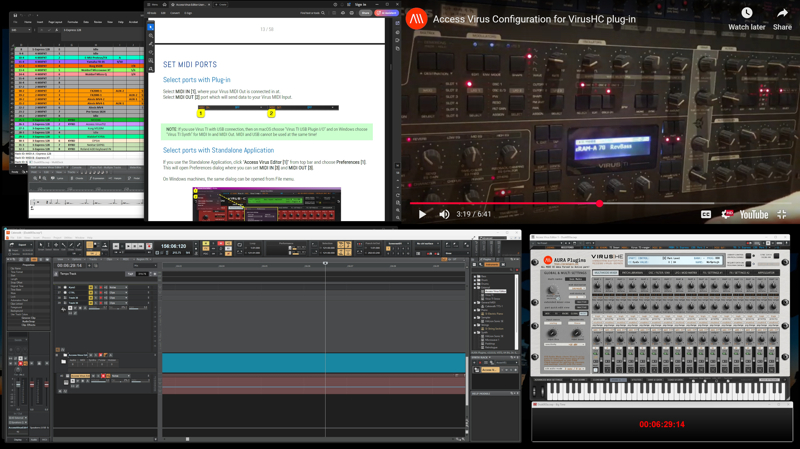
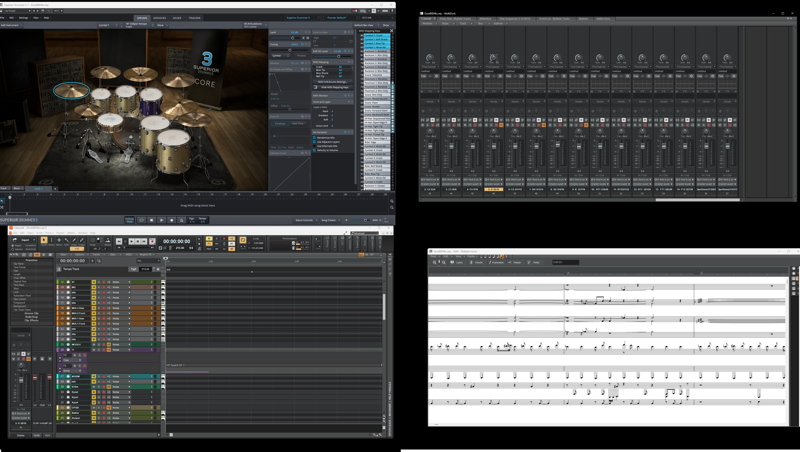
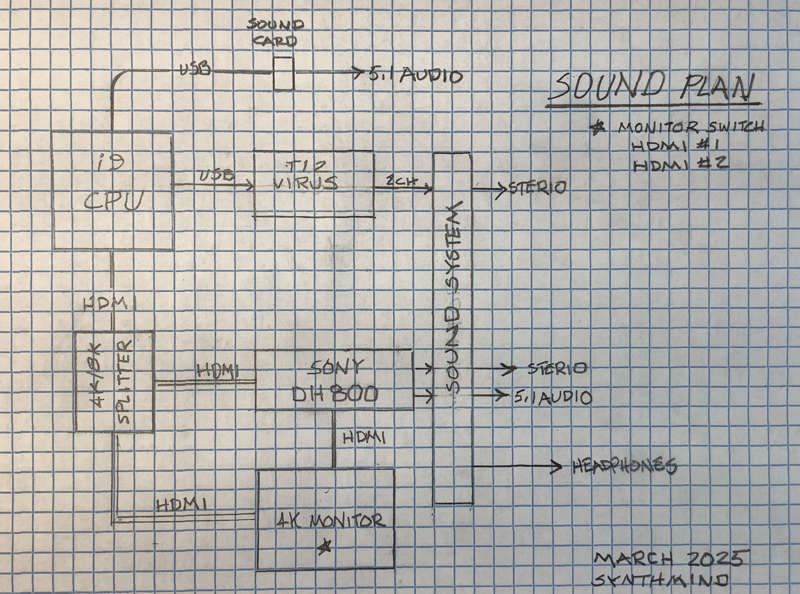
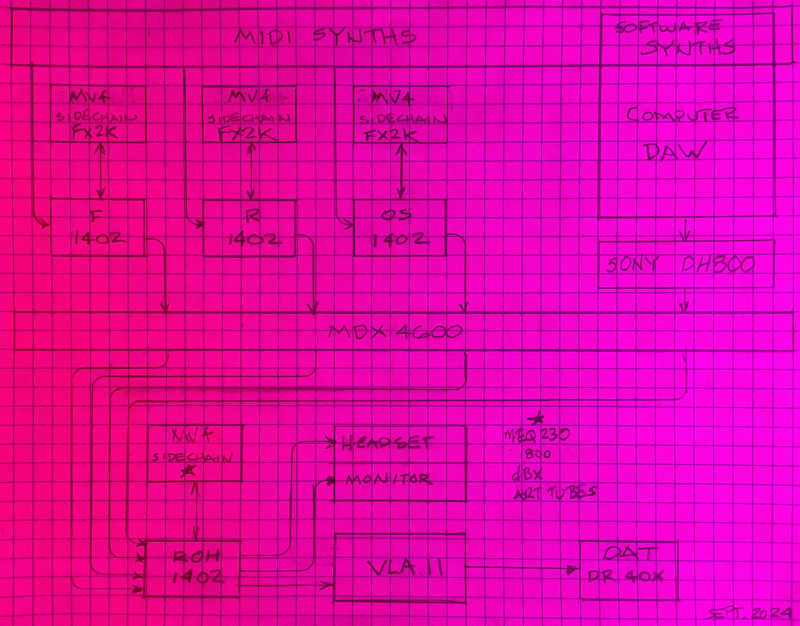
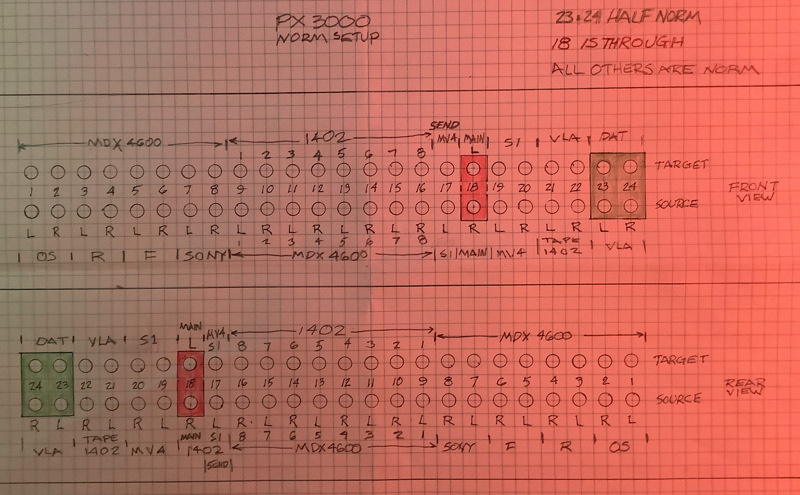
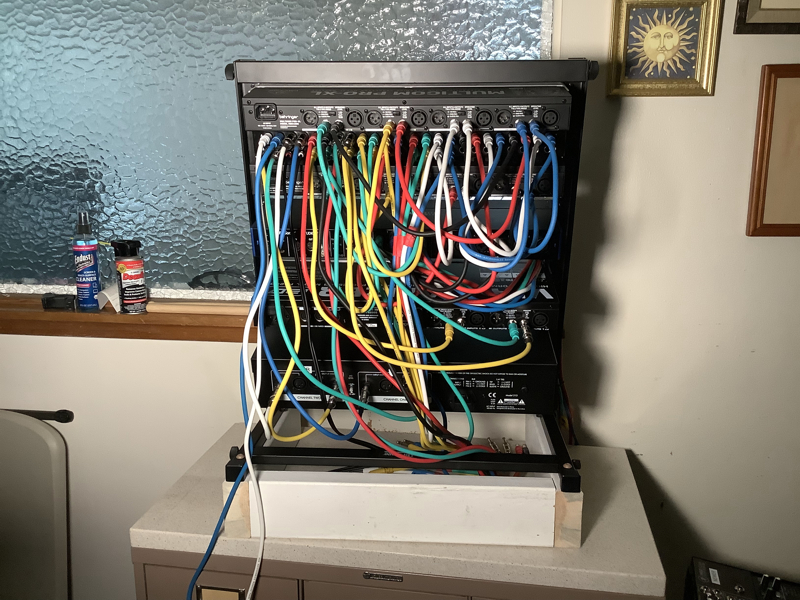
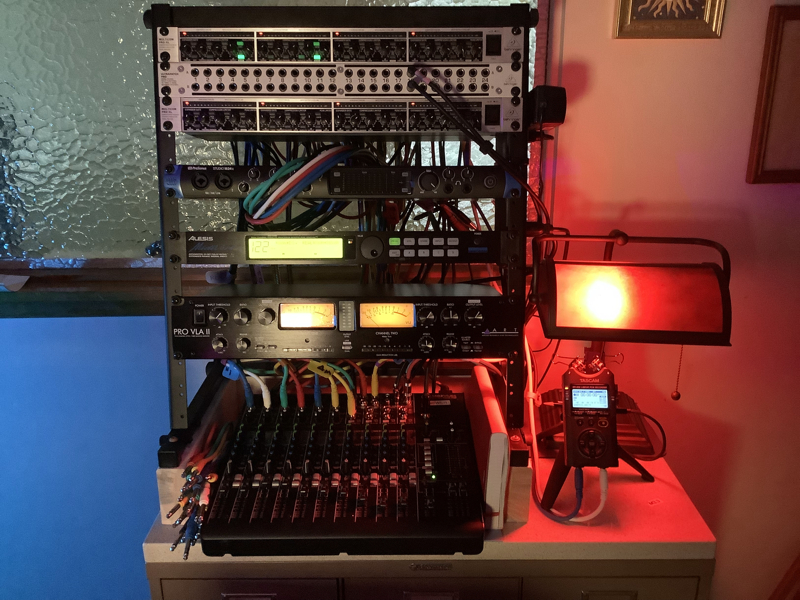
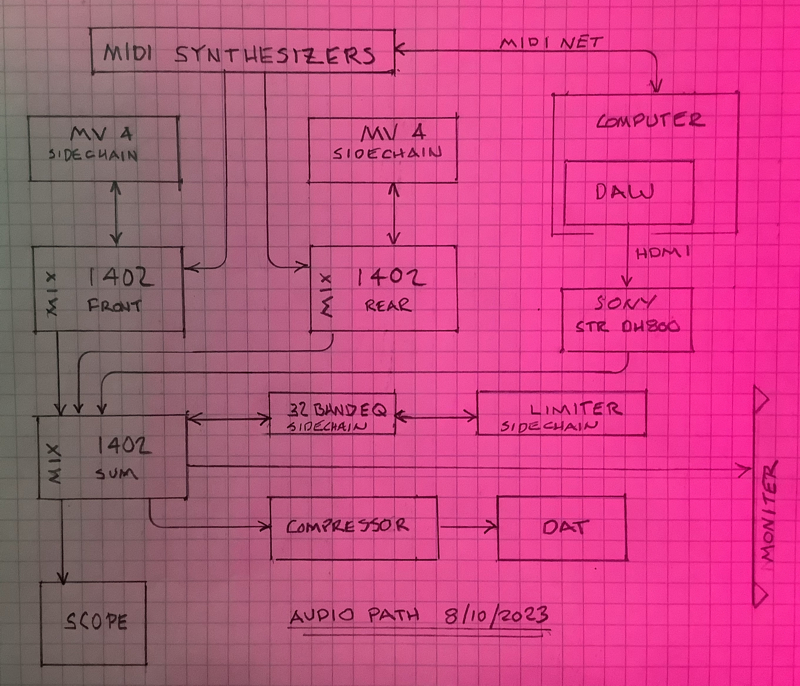































































.jpg)

